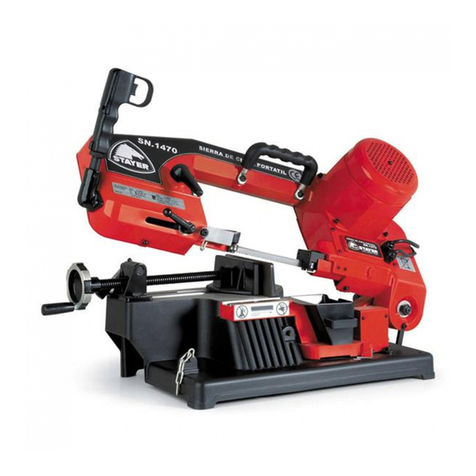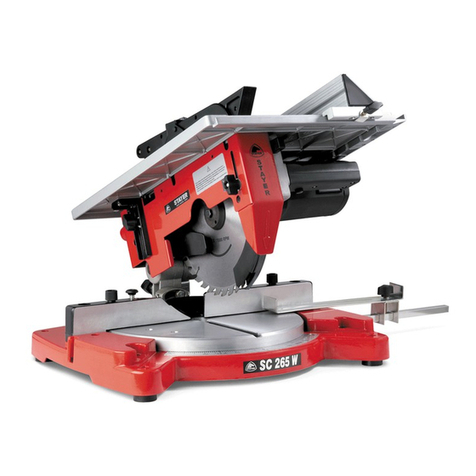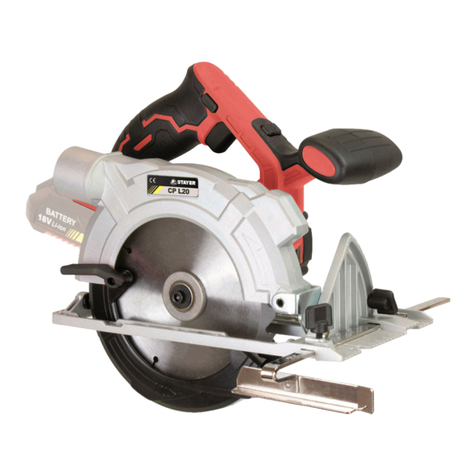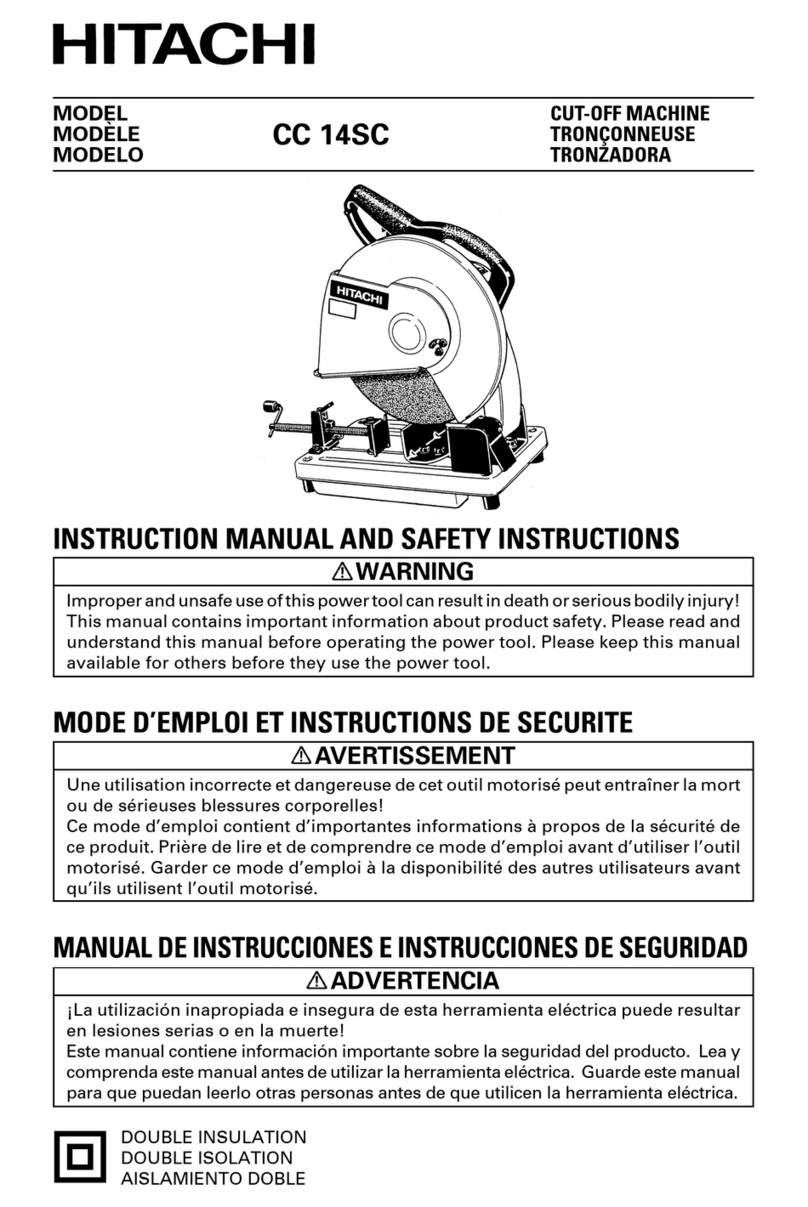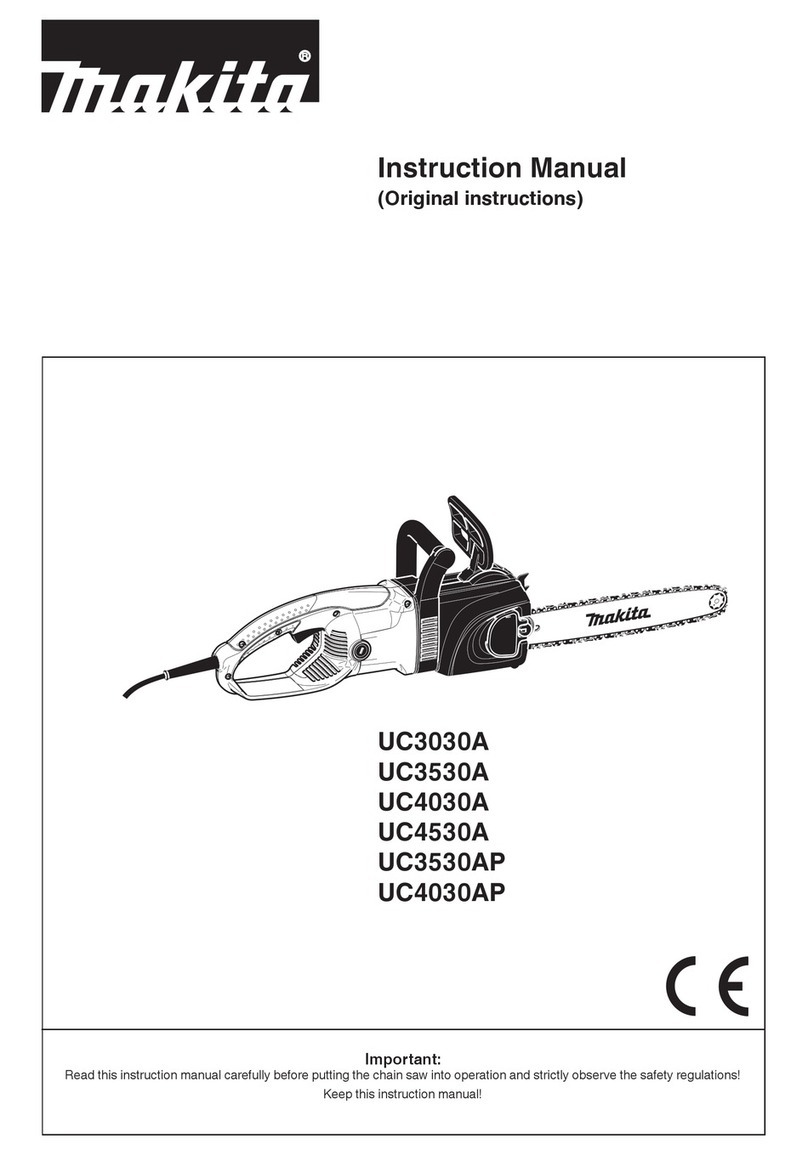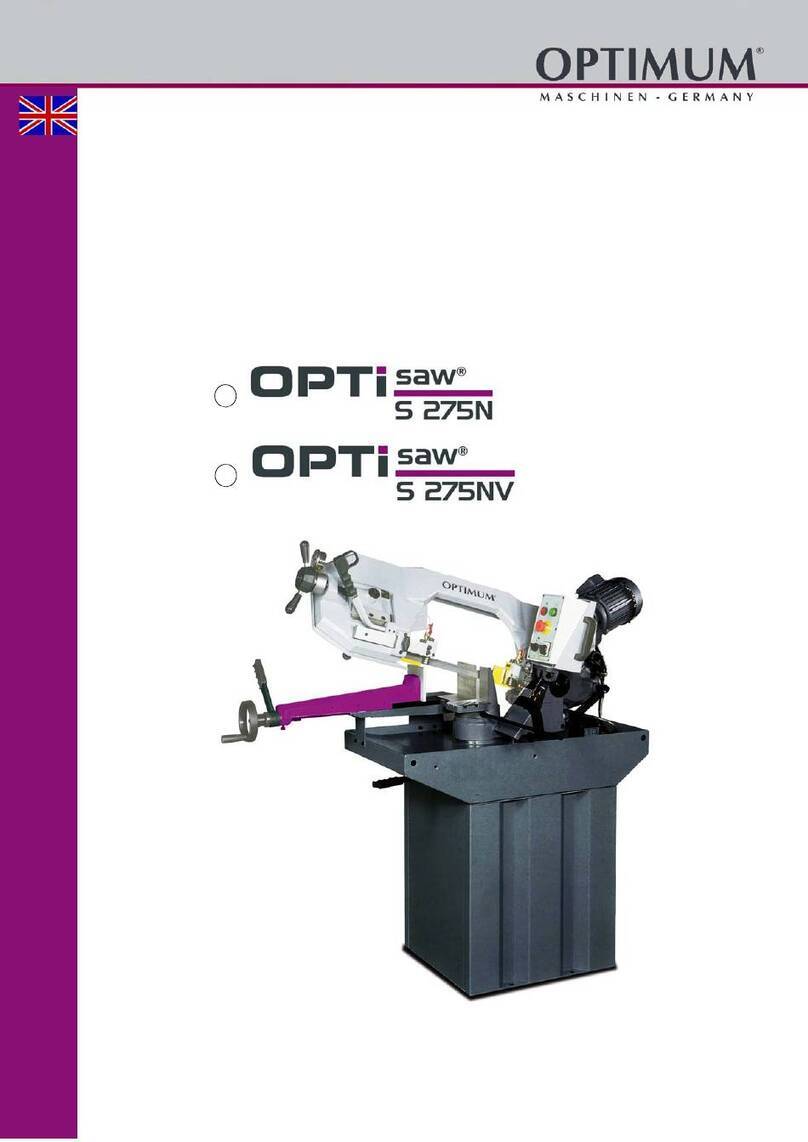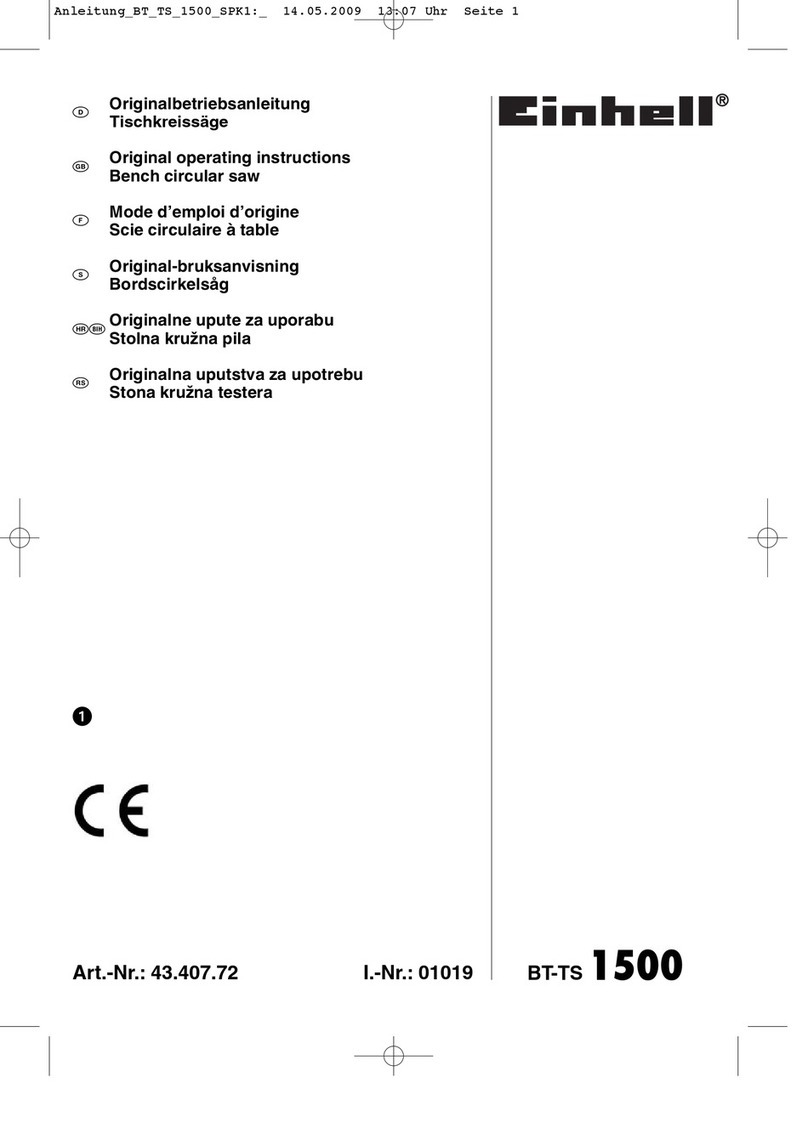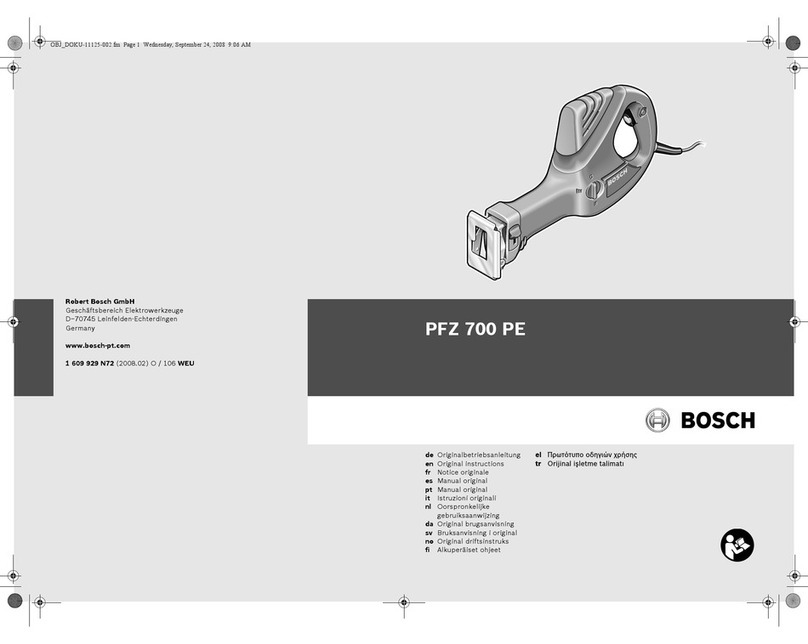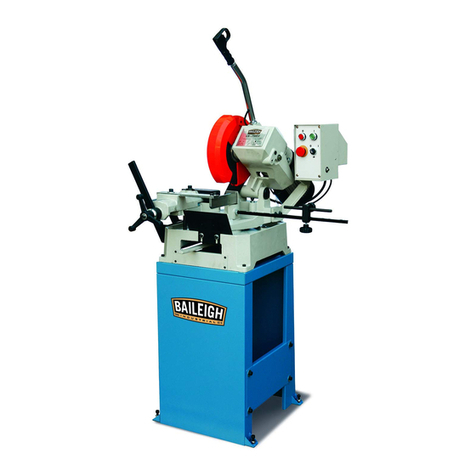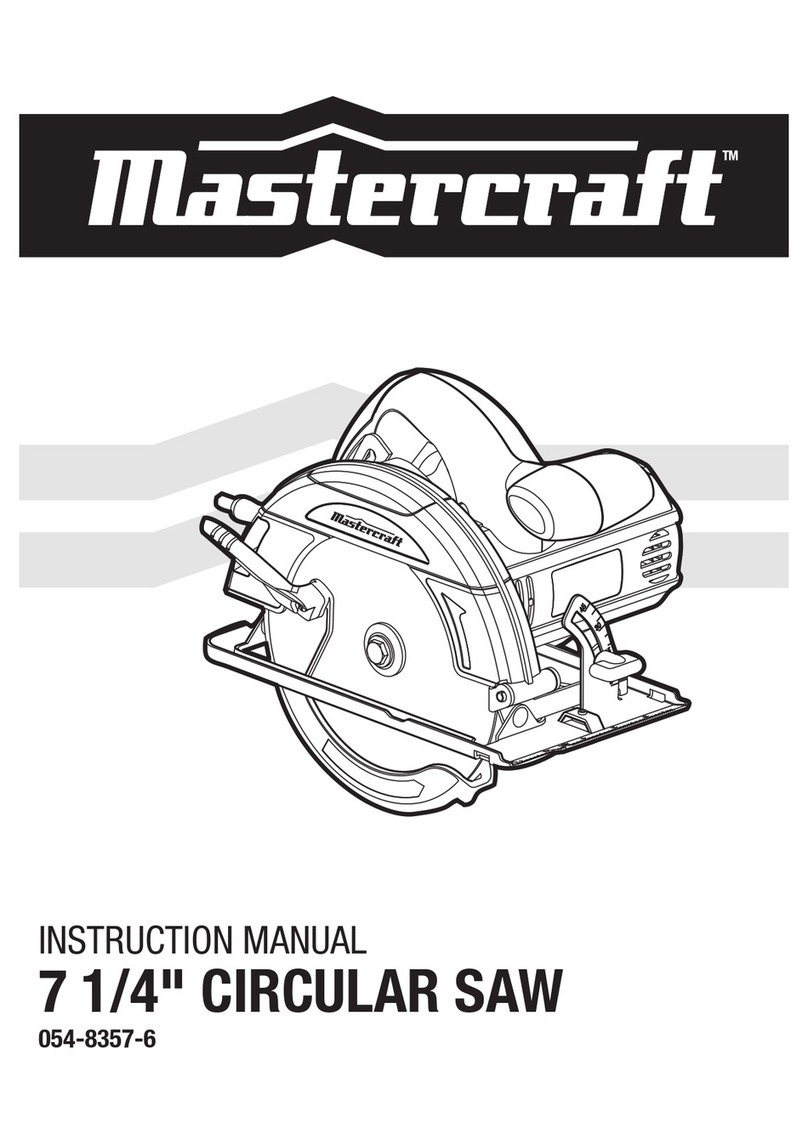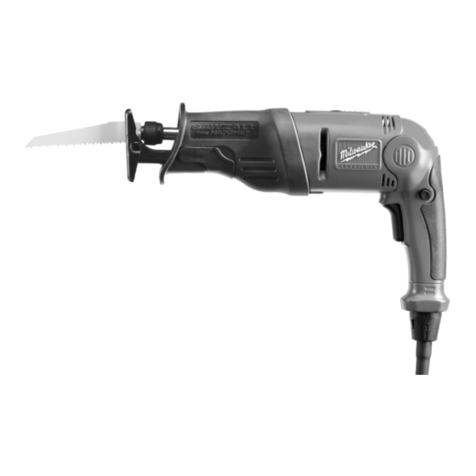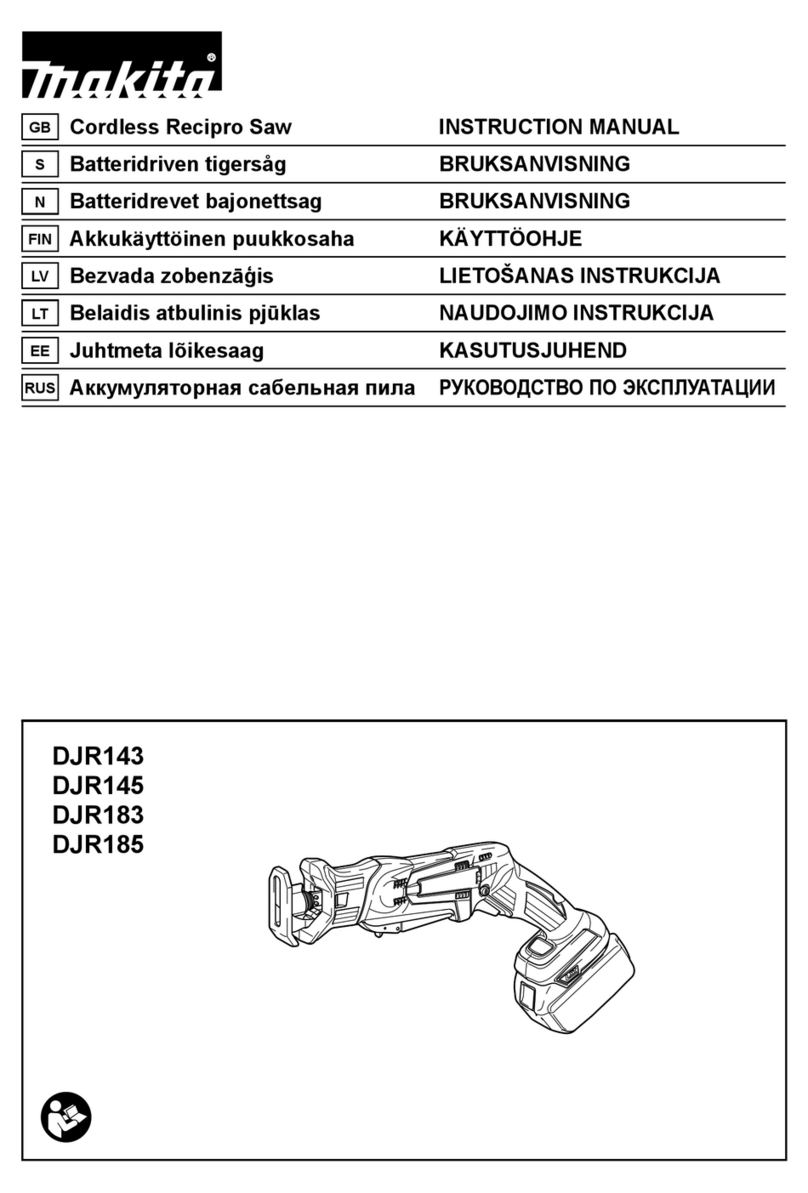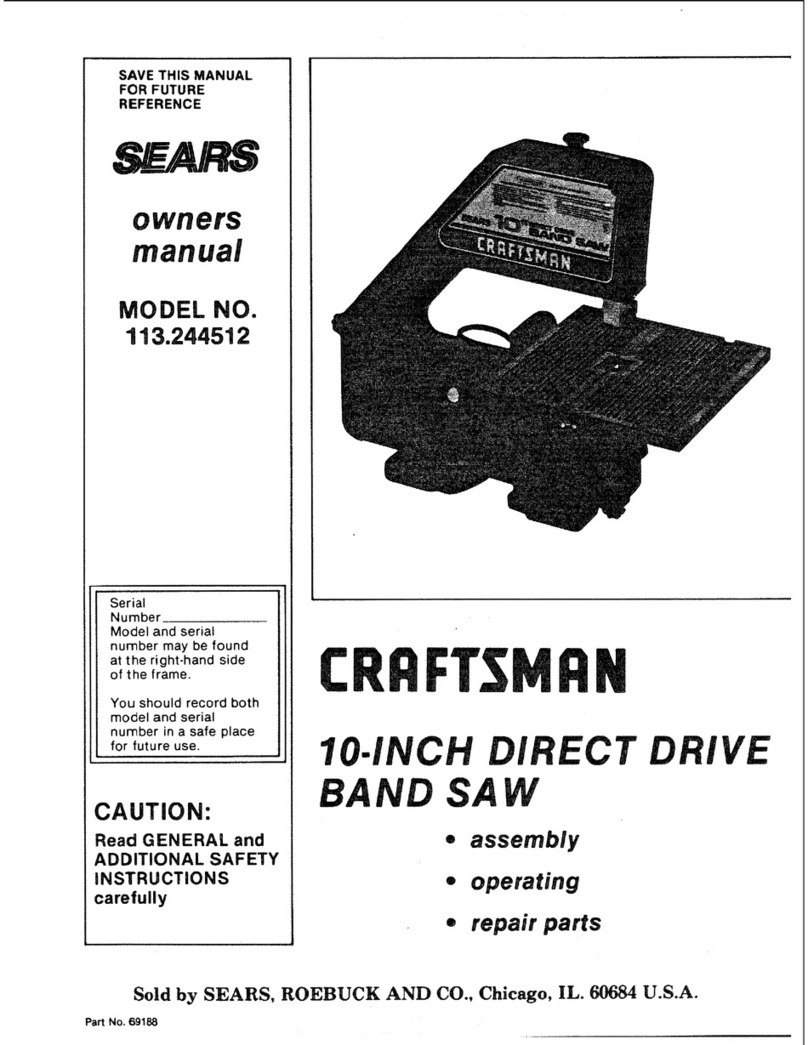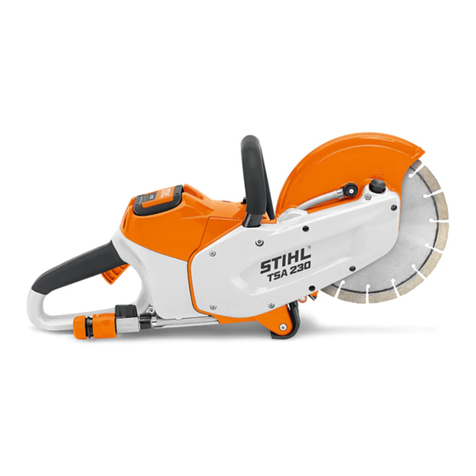stayer SCC315 User manual

es Manual de instrucciones SCC 315
www.grupostayer.com
gb Operating instructions
it Istruzioni d’uso
fr Instructions d´emploi
pt Instructions d´emploi
Área Empresarial Andalucía - Sector I
Calle Sierra de Cazorla nº7
C.P: 28320 Pinto (Madrid) SPAIN
info@grupostayer.com
pl Instrukcja obsługi
cz Návod k použití– překlad z originálu

ES
Declaramos bajo nuestra responsabilidad, que el producto descrito bajo “Datos técnicos” está en
conformidad con las normas o documentos normalizados siguientes: EN 62841-1, EN 61029-2-11,
EN 55014-1, EN 55014-2, EN 61000-3-2, EN 61000-3-3 de acuerdo con las regulaciones 2006/42/
CE, 2014/35/UE, 2014/30/UE, 2011/65/UE.
IT
Noi dichiariamo sotto la nostra unica e sola responsabilita che questo prodotto si trova in conformita
con le norme o i documenti normalizza liseguenti: EN 62841-1, EN 61029-2-11, EN 55014-1, EN
55014-2, EN 61000-3-2, EN 61000-3-3, secondo le normetive 2006/42/CE, 2014/35/UE, 2014/30/
UE, 2011/65/UE.
GB
I declare under our responsibility that the product described under “Technical Data” is in accordance
with the following standards or standardized documents: EN 62841-1, EN 61029-2-11, EN 55014-
1, EN 55014-2, EN 61000-3-2, EN 61000-3-3, according to regulations 2006/42/CE, 2014/35/UE,
2014/30/UE, 2011/65/UE.
DE
Wir erklären in alleiniger Verantwortung, dass dieses Produkt mit den folgenden Normen oder
normativen Dokumenten übereinstimmt: EN 62841-1, EN 61029-2-11, EN 55014-1, EN 55014-2,
EN 61000-3-2, EN 61000-3-3, gemäß den Bestimmungen der Richtlinien 2006/42/CE, 2014/35/
UE, 2014/30/UE, 2011/65/UE.
FR
Je déclare sous notre responsabilité que le produit décrit sous «Caractéristiques techniques» est
en conformité avec les normes ou documents normalisés suivants: EN 62841-1, EN 61029-2-
11, EN 55014-1, EN 55014-2, EN 61000-3-2, EN 61000-3-3, conformément à la réglementation
2006/42/CE, 2014/35/UE, 2014/30/UE, 2011/65/UE.
P
Declaro, sob nossa responsabilidade que o produto des-crito em “Dados técnicos” está em
conformidade com as seguintes normas ou documentos normativos: EN 62841-1, EN 61029-2-11,
EN 55014-1, EN 55014-2, EN 61000-3-2, EN 61000-3-3 de acordo com os regulamentos 2006/42/
CE, 2014/35/UE, 2014/30/UE, 2011/65/UE.
TR
Bu ürünün aşağıdaki standart ve standardizasyon belgeleri ile uyumunun doğruluğunu yegane
sorumluluğumuz altında beyan ederiz. 2006/42/CE, 2014/35/UE, 2014/30/UE, 2011/65/UE.
direktierinin hükümleri uyarınca EN 62841-1, EN 61029-2-11, EN 55014-1, EN 55014-2, EN
61000-3-2, EN 61000-3-3.
PL
Oświadczamy, że produkty przedstawione w rozdziale Dane techniczne” odpowiadają wymaganiom
następujących norm i dokumentów normatywnych: DYREKTYWY EUROPEJSKIE: 2006/42/CE,
2014/35/UE, 2014/30/UE, 2011/65/UE. NORMY ZWIĄZANE: EN 62841-1, EN 61029-2-11, EN
55014-1, EN 55014-2, EN 61000-3-2, EN 61000-3-3.
CZ
Prohlašujeme v plné své zodpovědnosti, že výrobek uvedený v části, Technické parametry „ je v
souladu s následujícími normami a normativními dokumenty: EN 62841-1, EN 61029-2-11, EN
55014-1, EN 55014-2, EN 61000-3-2, EN 61000-3-3, a v souladu s požadavky směr-nic 2006/42/
CE, 2014/35/UE, 2014/30/UE, 2011/65/UE.
EL
Δηλώνω υπό την ευθύνη μου ότι το προϊόν που περιγράφεται στο «Τεχνικά Στοιχεία» είναι σύμφωνο
με τα παρακάτω πρότυπα ή τυποποιημένα έγγραφα: EN 62841-1, EN 61029-2-11, EN 55014-1, EN
55014-2, EN 61000-3-2, EN 61000-3-3 σύμφωνα με τους κανονισμούς 2006/42/CE, 2014/35/UE,
2014/30/UE, 2011/65/UE.
ES. Declaración de Conformidad IT. Dichiarazione di conformità GB. Declaration of Conformity
DE. Konformitätserklärung FR. Déclaration de Conformité P. Declaração de conformidade
TR. Uygunluk beyanı PL. Deklaracja zgodności CZ. Prohlášení o shodě
EL. Δήλωση Συμμόρφωσης
Ramiro de la fuente
Director Manager
2022
Área Empresarial Andalucía - Sector 1
C/ Sierra de Cazorla, 7
28320 - Pinto (Madrid) SPAIN
Email: sales@grupostayer.com
Email: info@grupostayer.com

ø90º 45/90º 90/45º 45/45º Upper
Table
SCC315 315 x 30 165 100 115 x 100 170 x 65 62 x 62 0 - 45
MÁXIMA CAPACIDAD DE CORTE ALTURA / ANCHURA
MASSIMA CAPACITÀ DI TAGLIO ALTEZZA / LARGHEZZA
MAXIMUM CUTTING CAPACITY HEIGHT / WIDTH
MAXIMALE SCHNEIDKAPAZITÄTSHÖHE / BREITE
CAPACITÉ DE COUPE MAXIMALE HAUTEUR / LARGEUR
CAPACIDADE MÁXIMA DE CORTE, ALTURA / LARGURA
MAKSİMUM KESME KAPASİTESİ YÜKSEKLİK / GENİŞLİK
MAKSYMALNA WYDAJNOŚĆ CIĘCIA WYSOKOŚĆ / SZEROKOŚĆ
MAXIMÁLNÍ VÝŠKA / ŠÍŘKA ŘEZNÉ KAPACITY
ΜΕΓΙΣΤΟ ΙΚΑΝΟΤΗΤΑ ΚΟΠΗΣ ΥΨΟΣ / ΠΛΑΤΟΣ
W rpm kg K=3dB
LPA LWA
SCC315 2000 4000 22 II 98 101
FICHA TÉCNICA
SCHEDA TECNICO
TECHNICAL DATA
TECHNISCHE EIGENSCHAFTEN
FICHE TECHNIQUE
FOLHA TÉCNICA
TEKNIK VERILER
KARTA TECHNICZNA /
TECHNICKÉ PARAMETRY
ΦΥΛΛΟ ΔΕΔΟΜΕΝΩΝ

1
3
4
9
9
10
15
12
13
10
AB
4A
16
7
8

4
4
16
11
5
6
7
8
9
10
10
12
13
C D E F G
3
1

1
2
3
13
14
17 16
4
4A
7
10
9
H
YOUTUBE VIDEO SCC 315 - SCC255

ESPAÑOL
7
7
Instrucciones generales de seguridad para
herramientas eléctricas
1) Puesto de trabajo
a) Mantenga limipo y bien iluminado su puesto de
trabajo. El desorden y una iluminación deciente en las
áreas de trabajo pueden provocar accidentes.
b) No utilice la herramienta eléctrica en un entorno
con peligro de explosión, en el que se encuentren
combustibles líquidos, gases o material en polvo. Las
herramientas eléctricas producen chispas que pueden lle-
gar a inamar los materiales en polvo o vapores.
c) Mantenga alejados a los niños y otras personas de
su puesto de trabajo al emplear la herramienta eléctri-
ca. Una distracción le puede hacer perder el control sobre
el aparato.
2) Seguridad eléctrica
a) El enchufe de la herramienta eléctrica debe corres-
ponder a la toma de corriente utilizada. No es admisi-
ble modicar el enchufe en forma alguna. No emplee
adaptadores con herramientas eléctricas dotadas de
una toma de tierra. Los enchufes sin modicar adecua-
dos a las respectivas tomas de corriente reducen el riesgo
de una descarga eléctrica.
b) Evite que su cuerpo toque partes conectadas a tie-
rra como tuberías, radiadores, cocinas y refrigerado-
res. El riesgo a quedar expuesto a una sacudida eléctrica
es mayor si su cuerpo tiene contacto con tierra.
c) No exponga las herramientas eléctricas a la lluvia y
evite que penetren líquidos en su interior. Existe el pe-
ligro de recibir una descarga eléctrica si penetran ciertos
líquidos en la herramienta eléctrica.
d) No utilice el cable de red para transportar o col-
gar la herramienta eléctrica, ni tire de él para sacar el
enchufe de la toma de corriente. Mantenga el cable
de red alejado del calor, aceite, esquinas cortantes o
piezas móviles. Los cables de red dañados o enredados
pueden provocar una descarga eléctrica.
e) Al trabajar con la herramienta eléctrica a la intem-
perie utilice solamente cables de prolongación homo-
logados para su uso en exteriores. La utilización de un
cable de prolongación adecuado para su uso en exterio-
res reduce el riesgo de una descarga eléctrica.
f) Si fuera necesario utilizar la herramienta eléctrica
en un entorno húmedo, utilice un interruptor de pro-
tección diferencial. La utilización de un cable de pro-
longación adecuado para su uso en exteriores reduce el
riesgo de una descarga eléctrica.
3) Seguridad de personas
a) Esté atento a lo que hace y emplee la herramien-
ta eléctrica con prudencia. No utilice la herramienta
eléctrica si estuviese cansado, ni tampoco después
de haber consumido alcohol, drogas o medicamen-
tos. El no estar atento durante el uso de una herramienta
eléctrica puede provocarle serias lesiones.
b) Utilice un equipo de protección y en todo caso
unas gafas de protección. El riesgo de lesionarse se
reduce considerablemente si, dependiendo del tipo y la
aplicación de la herramienta eléctrica empleada, se utiliza
un equipo de protección adecuado como una mascarilla
antipolvo, zapatos de seguridad con suela antideslizante,
casco, o protectores auditivos.
c) Evite una puesta en marcha fortuita del aparato.
Asegúrese de que la herramienta eléctrica está apa-
gada antes de conectarla a la toma de corriente y/o la
batería, de desconectarla o de transportarla. Si trans-
porta la herramienta eléctrica sujetándola por el interrup-
tor de conexión/desconexión, o si introduce el enchufe en
la toma de corriente con el aparato conectado, puede dar
lugar a un accidente.
d) Retire las herramientas de ajuste o llaves jas antes
de conectar la herramienta eléctrica. Una herramienta
o llave colocada en una pieza rotante puede producir le-
siones al ponerse a funcionar.
e) Evite trabajar con posturas forzadas. Trabaje so-
bre una base rme y mantenga el equilibrio en todo
momento. Ello le permitirá controlar mejor la herramienta
eléctrica en caso de presentarse una situación inespera-
da.
f) Lleve puesta una vestimenta de trabajo adecuada.
No utilice vestimenta amplia ni joyas. Mantenga su
pelo, vestimenta y guantes alejados de las piezas mó-
viles. La vestimenta suelta, las joyas y el pelo largo se
pueden enganchar con las piezas en movimiento.
g) Siempre que sea posible utilizar equipos de as-
piración o captación de polvo, asegúrese que éstos
estén montados y que sean utilizados correctamente.
La utilización de un equipo de aspiración de polvo puede
reducir los riesgos de aspirar polvo nocivo para la salud.
4) Trato y uso cuidadoso de herramientas eléctricas
a) No sobrecargue el aparato. Use la herramienta
prevista para el trabajo a realizar. Con la herramienta
adecuada podrá trabajar mejor y más seguro dentro del
margen de potencia indicado.
b) No utilice herramientas con un interruptor defec-
tuoso. Las herramientas que no se puedan conectar o
desconectar son peligrosas y deben hacerse reparar.
c) Saque el enchufe de la red y/o retire la batería an-
tes de realizar un ajuste en la herramienta, cambiar de
accesorio o guardar el aparato. Esta medida preventiva
reduce el riesgo de conectar accidentalmente el aparato.
d) Guarde las herramientas eléctricas fuera del alcan-
ce de los niños. No permita que las utilcen personas
que no estén familiarizadas con ellas o que no hayan
leído estas instrucciones. Las herramientas utilizadas
por personas inexpertas son peligrosas.
e) Cuide sus herramientas eléctricas con esmero.
Controle si funcionan correctamente, sin atascarse,
las partes móviles de la herramienta y si existen par-
tes rotas o deterioradas que pudieran afectar a su
funcionamiento. Si la herramienta eléctrica estuviese
defectuosa, hágala reparar antes de volver a utilizarla.
Muchos de los accidentes se deben a aparatos con un
mantenimiento deciente.
f) Mantenga los útiles limpios y alados. Los útiles
mantenidos correctamente se dejan guiar y controlar me-
jor.
g) Utilice las herramientas eléctricas, los accesorios,
las herramientas de inserción, etc. de acuerdo con es-
tas instrucciones. Considere en ello las condiciones
de trabajo y la tarea a realizar. El uso de herramientas
eléctricas para trabajos diferentes de aquellos para los
que han sido concebidas puede resultar peligroso.

ESPAÑOL
8
8
Este manual es acorde con la fecha de fabricación de su
máquina, información que encontrará en la tabla de datos
técnicos de la maquina adquirida, buscar actualizaciones de
manuales de nuestras maquinas en la página web: www.
grupostayer.com
1. USO PREVISTO DE LA MÁQUINA
Esta herramienta eléctrica ha sido proyectada única y
exclusivamente para:
1.Trabajar estacionariamente sobre supercieplana y estable.
2.Trabajar sobre piezas de maderas duras yblandas.
3.Trabajar sobre piezas de tableros de conglomerado.
4.Trabajar sobre piezas de tableros de bras.
5.Trabajar sobre piezas de tubo de PVC.
6.Realizar cortes rectilíneos a lo largo y ancho de lapieza a
trabajar.
7.Realizar cortes a inglete horizontal entre -45º y45º
Realizar cortes a inglete vertical entre 90º y 45º
Consulte los límites de tamaño de pieza en el apartado 11
correspondiente.
2. DESEMBALADO Y ENSAMBLADO
Desembalado
1. Abrir la caja cortando el precinto.
2. Retirar los topes de cartón superiores.
3. Extraer la máquina de la caja, sujetando rmemente la
cabeza operadora y el cuerpo del motor, utilizando ambas
manos para equilibrar el peso.
4. Extraer la caja de accesorios.
5. Extraer la documentación.
6. Conservar permanentemente la caja de cartón, sus topes,
la caja de accesorios y la documentación en un ambiente
seguro, inventariado, de fácil acceso y conocido por el
operador de la máquina.
Ensamblado
Operación 1: Asegurar, plegar y jar la cabeza operadora,
para ello:
1.Poner el cabezal superior a 0º horizontales.
2.Poner el cabezal superior a 90º verticales
3.Colocar el protector de forma que haga contacto en la
mesa de corte.
4.Bajar el cabezal a tope, presentándolo para poder
bloquearlo con el botón.
Operación 2: Embalar la máquina.
1.Localizar la caja de cartón y sus topes.
2.Localizar la documentación.
3.Sujetar rmemente la máquina por la cabeza operadora y
el cuerpo del motor.
4.Depositar la maquina sobre las 4 hendiduras circulares de
la base de la caja.
5.Depositar la documentación de la máquina.
6.Colocar los topes de cartón superiores.
Cerrar la caja jándola con precinto.
3. ESTABLECIMIENTO O FIJACIÓN DE LA HERRAMIENTA
EN UNA POSICIÓN ESTABLE
1.Obligatoriamente el puesto de trabajo en el que se implanta
la máquina debe ser seguro.
2.Apoyar la herramienta en posición estable sobre una
supercie plana.
3.La base de la ingleteadora dispone de los cuatro oricios
jar sólidamente la máquina al banco de trabajo . Se re
comienda encarecidamente jar la máquina al banco
mediante los correspondientes tornillos y tuercas.
4. CONEXIÓN A LAALIMENTACIÓN, CABLEADO,
FUSIBLES, TIPO DE BASE PARA LA CLAVIJA Y
REQUISITOS PARA LA TOMA DE TIERRA
1.Para alimentar la máquina conectar la clavijaschuko a
una toma reglamentaria capaz de suministrar como mínimo
2500VA.
2.La máquina tiene su cableado interno completamente
terminado por lo que no necesita cableado alguno de
instalación.
3.La máquina no lleva fusibles, aunque serecomienda el uso
de un interruptor magnetotérmico dedicado como protección
de lamáquina.
4.La máquina dispone de un equipo eléctrico decategoría II,
por lo que no hace uso de la toma de
tierra de la instalación eléctrica.
5. DESCRIPCIÓN ILUSTRADA DE LAS FUNCIONES
1. Pomo selector de angulo (inglete).
2. Protector de la mesa inferior para uso de mesa superior.
3. Botón de desbloqueo de cabezal.
4. Ajustes de nivelación de mesa superior.
4A. Tornillos de bloqueo
5. Bulón de bloqueo del cabezal en posición inferior.
6. Tope de bajada de disco.
7. Tornillos de ajuste de inclinación del disco 0º/45º.
8. Pomo de selección de la inclinación del cabezal (bisel).
9. Inserción de soporte de corte largo (SCC315W).
10. Inserción de mordazas.
11. Palanca de bloqueo del disco
12. Interruptor para ingletadora / mesa inferior
13. Interruptores ON/OFF con enclave en mesa superior
14. Bloqueo de seguridad para uso de mesa inferior
15. Bloqueo de seguridad para uso con mesa superior
16. Guía lateral / Protector de la mesa superior
17. Cubre disco mesa superior
A- Mesa inferior con escalímetro de grados
B- Mesa superior y Cubre disco superior
C- Ejes de giro del cabezal
D- Cubre disco inferior
E- Salida para conexión con aspirador
F- Cabezal
G- Empuñadura y motor
H- Soporte extensible para piezas grandes SCC315 (x2)
6. LIMITACIONES SOBRE LAS CONDICIONES
AMBIENTALES
El grado IP de esta máquina eléctrica es 20. Esta máquina
esta protegida contra acceso a partes peligrosas con un
dedo y contra los cuerpos sólidos extraños de 12’5 mm de
diámetro y mayores. Esta máquina eléctrica no tiene ninguna
clase de protección contra la penetración del agua por lo que
se prohíbe su uso en condiciones ambientales exteriores o
interiores con riesgo de precipitación.
7. AJUSTES Y ENSAYOS
¡Advertencia!

ESPAÑOL
9
9
Antes de cualquier intervención en la herramienta eléctrica,
sacar el enchufe de red de la toma de corriente.
Si la máquina ha estado sometida a un uso prolongado o
intenso es necesaria su vericación y ajuste para asegurar
la correcta calidad de servicio y la seguridad de la máquina.
Para ello se requiere conocimientos, experiencia y
herramientas especiales. El servicio técnico ocial de Stayer
Iberica S.A. realizará para usted este trabajo de manera
rápida, concienzuda y económica.
Enclavamiento en posición de reposo inferior
Vericación
1. Parte con el cabezal levantado
2.Desbloquee el cabezal apretando el botón 3.
3.Bajar el cabezal hasta el tope inferior.
4.Tirar del bulón 5, girarlo 90º y volver a introducirlo en su
ranura. Si esta bien ajustado el bulón debe entrar suavemente
hasta hacer tope dejando el cabezal enclavado. Si el bulón
no encaja:
Ajuste
1.Mediante 3 bajar el cabezal hasta el tope inferior
2.Apretar o aojar el tornillo 6 hasta que el botón 5 penetre a
tope suavemente.
Ajuste del ángulo de corte vertical a -45º (bisel)
Vericación
1. Aojar el pomo de control del ángulo del cabezal (8)
girándolo como una manivela.
2. Mover el cabezal hasta el tope derecho (-45º).
3. Comprobar el ángulo mediante un patrón angular
debidamente calibrado o un goniómetro (precisión mínima +-
5’) presentando una sus las supercies en la mesa de corte y
la otra en el disco de corte.
4. Si la cara del patrón no ajustase exactamente con el disco
o si en la medida directa del goniómetro se alcanzase una
desviación mayor +- 20’ se procederá al ajuste.
Ajuste
1. Colocar un goniómetro (precisión mínima +- 5’) presentando
una sus las supercies en la mesa de corte y la otra en el
disco de corte.
2. Intervenir sobre los tornillos de ajuste (7) hasta obtener
una medida de 45º
Ajuste del cuchillo separador
El cuchillo separador es el soporte que sujeta el cubre disco
de la mesa superior (17). Su función es separar y desviar los
desechos producidos por el corte cuando se utiliza la mesa
de corte superior para que estos no fecten al usuario.
Esta pieza metálica debe estar siempre a una distancia
mínima de 2 mm del disco. Para regular su posición debe
seguir los siguientes pasos:
1- Enclavar la máquina en posición inferior.
2- Aojar los tornillos de regulación de la mesa superior (4), y
levantar la mesa a su máxima altura posible
3- Utilice los tornillos ubicados detrás del regulador de la
mesa de corte 4A para ajustar la posición de la cuchilla.
X
Y
X
Y
X
Y
8. CAMBIO DE HERRAMIENTA
¡Atención!
Realizar esta operación con la maquina desenchufada y la
hoja inmóvil. Utilizar guantes de protección.
- Usar obligatoriamente discos según EN 847-1
- Usar obligatoriamente el palo reglamentario de empuje y
guárdelo cuando no lo use.
- Prohibido el uso de discos de acero rápido (HSS)
- Prohibido el uso de discos defectuosos o deformados
Retirada del disco de corte
1.Colocar la herramienta en posición de enclavamiento
inferior o reposo
2. Desmontar el portector del disco superior (17) aojando el
tornillo trasero y tirando de la pieza hacia arriba con cuidado.
3. Una vez expuesto el disco por la mesa superior, aoje los
tornillos de ajuste de la mesa superior. En el caso de 4A son
2 tornillos de estrella, en los otros 3 puntos de ajuste (4) son
tornillos allen.
4. Una vez aojados los tornillos (4) tirar suavemente de la
mesa superior, extraerla y retirarla.
5. Sujetando con la mano derecha la palanca de bloqueo del
disco (11), proceda a desatornillar el tornillo y arandela de
sujección del disco. El tornillo de sujección del disco se aoja
girando en el sentido de las agujas del reloj.
Cambio del disco de corte
1.Limpiar cuidadosamente el serrín y suciedad de los apoyos,
bridas e interior de los resguardos.
2.Colocar el nuevo disco de corte de manera que el sentido
de la echa del frontal del cárter coincida con la echa
grabada en el disco y con la propia inclinación de los dientes
del disco.
3.Colocar la arandela y su tornillo. Apretar el tornillo en el
sentido opuesto a las agujas del reloj
4. Colocar la mesa superior en su sitio y apretar todos los
tornillos de ajuste (4).
5. Colocar nuevamente el protector del disco superior y
apretar los tornillos para jarlo en su posición.
6.Revisar la operación simulando en vacío una operación de
corte.
9. FIJACIÓN DE TRABAJO
Siempre que sea posible se jará la pieza de manera
queno intervenga la mano. Durante el corte, sujetar
la piezaestablemente contra el apoyo. TODAS LAS
MÁQUINAS ESTÁN PREPARADAS PARA EL MONTAJE
DE MORDAZAS QUE PERMITANFIJAR DE MANERA
SEGURA EL PERFIL.
Para evitar la deformación de las piezas durante la jación
se aconseja utilizar unos perles de madera, fácilmente
aplicables a las mandíbulas móviles de las mordazas. Las
Mordazas se extraen fácilmente y dejan la supercie de
trabajototalmente libre.
Para cortar piezas largas en condiciones seguras,es
indispensable sujetarlas con soportes adicionales.
10. LÍMITES SOBRE EL TAMAÑO DE LA PIEZA DE
TRABAJO
Límites de trabajo para todos los modelos incluidos en el
presente manual en página 3

ESPAÑOL
10
10
11. INSTRUCCIONES GENERALES DE UTILIZACIÓN
¡Advertencia! Debe:
1. Si la máquina está en mal estado o carece de piezas,
incluyendo los resguardos reglamentarios superiores (puede
usar las ilustraciones del presente manual como guía
orientativa). No use la máquina. Desconéctela, retírela del
puesto de trabajo y envíela inmediatamente a un servicio
técnico autorizado.
2. Conocer y cumplir todas las medidas de seguridad antes
de arrancar la máquina.
Uso obligatorio de sistema de aspiración de partículas
cuando se corta madera.
ARRANQUE Y PARADA DE LA MÁQUINA
Información
1.Laherramientadisponede2mecanismosdeaccionamiento
y desconexión diferentes en función del uso que se le vaya
a dar a la herramienta. Como ingletadora solo dispone de
interruptor de conexión/desconexión (12) mientras que
al usar la herramienta como mesa de corte el mecanismo
de encendido y apagado se compone de 2 botones que
enclavan el motor de la máquina directamente (13).
Ambos sistemas de arranque y parada son excluyentes, no
pueden usarse indistintamente o de forma simultánea por
motivos de seguridad
2. El equipo dispone de un módulo de seguridad que le
protege de arranques no esperados. Si mientras la máquina
está arrancada cesase el suministro eléctrico al reactivarse
este la máquina no arrancará. Para liberar la protección
pulsar dos veces el interruptor de arranque.
¡Advertencia!
1. No dejar nunca desatendida la máquina en funcionamiento.
2. Jamás arranque con el disco bloqueado y antes de
comenzar el corte siempre espere a que el disco de corte
alcance la velocidad máxima.
3. Antes de parar la máquina el disco debe estar despejado
y girando libremente.
Arranque y parada como ingletadora/mesa de corte
inferior
Arranque: Presionar el interruptor rectangular (12) del mango
para un accionar el motor.
Parada: Dejar de presionar el interruptor rectangular.
Arranque y parada como mesa de corte superior con
enclave automático (13)
Arranque: Presione el botón verde I.
Parada: Presione el botón rojo O
USO CON LA MESA DE CORTE INFERIOR
¡Advertencia!
1.Se ha de eliminar el riesgo de accidente por contacto con
el disco de corte por su aparición en la mesa superior. Por su
seguridad realice obligatoriamente la siguiente preparación
indicada antes de trabajar con la mesa inferior.
2.Cualquier preparativo se hará obligatoriamentecon el cable
desconectado.
ADVERTENCIA
SI NO INSTALA LA GUÍA LATERAL/PROTECTOR DE LA
MESA SUPERIOR (16) DE TAL MANERA QUE PRESIONE
EL BLOQUEO DE SEGURIDAD SUPERIOR (14) LA
MÁQUINA NO FUNCIONARÁ.
Preparación de seguridad de la mesa decorte
superior para cortes con la mesa inferior.
1. Si la máquina se encontrara plegada tire del bulón (5) ,
gírelo 90º y vuelva a introducirlo para desbloquear el cabezal
(F) de tal manera que este pueda alcanzar su posición
vertical.
Si la máquina tuviera el protector inferior colocado (2) retírelo
y guárdelo.
2. Coloque la guía lateral/protector de la mesa superior (16)
sobre el cubre disco superior (17) de tal manera que su
parte frontal apoye y presione sobre el botón de seguridad
de la mesa inferior (14). Apriete la palomilla de sujección del
protector (16).
La máquina no puede funcionar como ingletadora/mesa de
corte inferior si el botón (14) no queda pulsado y bloqueado.
Este botón inhabilita los botones de encendido y apagado
con enclavamiento (13) y habilita el uso del interruptor de la
empuñadura (12).
Operación de corte con la mesa de corte inferior
¡Advertencia!
1. Respete los límites de tamaño y material de la pieza a
trabajar.
2. Siempre que sea posible utilice mordazas y el palo de
empuje para sujetar la pieza a trabajar.
Preparación del corte inclinado horizontal en la
mesa inferior
Para seleccionar el ángulo de corte deseado siga los
sieguientes pasos:
Cortes a inglete (eje X= -45º/+60º, eje Y= 90º)
X
Y
X
Y
X
Y
Denominamos corte a inglete aquel que mantiene el cabezal
en posición vertical, perpendicular respecto a la mesa de
corte inferior. El cabezal puede rotar sobre su eje desde -45º
hasta +60º.
Para ajustar el ángulo de corte a inglete aoje el pomo
selector de ángulo (1) y tire del mismo para ir rotando la mesa
de corte inferior (A) hasta el ángulo deseado.
La mesa de corte inferior dispone de una pletina que marca
en el escalímetro de la mesa inferior el ángulo. Una vez
seleccionado el ángulo de corte deseado, apriete el pomo de
selección de ángulos (1).
Adicionalmente, la mesa inferior viene preparada para
ajustarse fácilmente a los ángulos de -45º / -30º / -15º / -7.5º
/ 0º / +15º / +30º / +60º. Para hacer uso de estos preajustes
libere el pomo (1), la mesa seguirá girando según vaya
empujando el pomo (1) y se detendrá automáticamente al
alcanzar cualquiera de los ángulos indicados, bloqueándose
en dicho ángulo hasta que se tire de nuevo del pomo (1).

ESPAÑOL
11
11
Cortes a bisel (eje X= 90º, eje Y= -45º/0º)
X
Y
X
Y
X
Y
Denominamos corte a bisel aquel en el que el cabezal
bascula sobre su eje para inclinarse, rompiendo así la
perpendicularidad con la mesa de corte inferior. Esta
herramienta permite que el cabezal bascule solo hacia el
lazo izquierdo.
Para ajustar el ángulo de corte a bisel aoje el pomo de
inclinación del cabezal (8) y bascule el cabezal hasta el
ángulo deseado, la máquina viene preparada por defecto
para bascular hasta los -45º. Puede utilizar el escalímetro
localizado junto al pomo (8) para anar el ángulo de corte.
Una vez seleccionado el ángulo de corte a bisel apriete de
nuevo el pomo (8).
Corte combinado (eje X= -45/+45º, eje Y= -45/0º)
X
Y
X
Y
X
Y
El corte compuesto supone una combinación de ángulos de
corte a bisel e inglete. Para seleccionar su corte combinado
deberá seguir los pasos descritos para corte a bisel y corte a
inglete simultáneamente.
Ejecución de la operación de corte en la mesa
inferior
1. Preparar la pieza a trabajar sujetándola con completa
seguridad.
2. Arrancar la máquina eléctrica pulsando el interruptor (12).
3. Espere unos segundos a que el disco de corte alcance su
velocidad máxima.
4. Bajar lentamente el cabezal presionando el botón
de desbloqueo (3) con ayuda de la empuñadura en un
movimiento continuo y sin tirones.
5. Ejercer presión en el sentido del avance de la hoja, con
una intensidad adecuada para el material que se haya de
cortar.
6. Una vez terminada la operación de corte, volver a levantar
el cabezal de operación. Parar la máquina dejando de pulsar
el interruptor.
Uso de los soportes extensores de corte largo (H)
La herramienta SCC315 incluye 2 soportes extensores para
corte de piezas de gran longitud (H). Los soportes se insertan
en las ranuras (9) y se jan con una palomilla ubicada junto
a las inserciones para mordazas (10). El uso de dichos
soportes es obligatorio por motivos de seguridad si la pieza a
cortar es de gran longitud
Uso como sierra circular mediante la mesa de corte
superior
Antes de cualquier operación en la mesa de corte superior
es obligatorio preparar adecuadamente la máquina. Para
ello se instalara el protector de seguridad estático en la mesa
inferior.
ADVERTENCIA
SI NO INSTALA EL PROTECTOR DE LA MESA INFERIOR
(2) DE TAL MANERA QUE PRESIONE EL BLOQUEO
DE SEGURIDAD INFERIOR (15) LA MÁQUINA NO
FUNCIONARÁ.
Instalación del resguardo de seguridad estático en
la mesa de corte inferior
1.Empezar con el cabezal alzado y el cable desconectado. Si
la guía lateral/ protector de seguridad superior (16) estuviera
instalado bloqueando el botón de seguridad superior (14),
aoje el tornillo y desplace la guía lateral jándola en otro
punto de la mesa de corte superior.
2.Insertar el protector de seguridad de la mesa inferior (2).
El protector debe encajarse completamente sobre la pieza
en la que se encuentra el botón de bloqueo de seguridad
inferior (15)
3.Bajar suavemente el cabezal pulsando el botón (3) y
bloquearlo mediante el bulón (5) tirando del mismo, girándolo
90º y volviendo a insertarlo.
4.Vericar que la hoja gira libremente.
5.Finalmente arrancar la máquina brevemente en vacío y
asegurarse de que el disco de corte no roza.
La máquina no puede funcionar como mesa de corte si
el protector inferior (2) no está completamente encajado
en el botón de bloqueo inferior (15). El botón de bloqueo
inferior (15) inhabilita el interruptor de la empuñadura de
la herramienta (12) y habilita los botones de encendido y
apagado con enclavamiento (13).
Preparación de la altura de la mesa superior de
corte
¡Advertencia!
La mesa de corte superior debe tener una altura respecto al
disco de corte de manera tal que solo sobresalga de la pieza
a cortar una altura igual a la del diente de corte.
1.Aojar los tornillos que regulan la altura de la mesa superior
(4).
4.Ajustar la altura de la mesa tirando suavemente hacia
arriba.
5.Apretar rmemente las palomillas (4) una vez se haya
alcanzado la altura deseada.
Preparación de la ancho de corte en la mesa
superior de corte mediante guía.
1.Libere el movimiento de la guía paralela (16) aojando la
palomilla.
2.Ajustar el ancho de corte moviendo la guía sobre la escala
graduada.
3.Fije la guía (17) apretando sólidamente la palomilla.
Ejecución de la operación de corte en la mesa
superior:

ESPAÑOL
12
12
1. Realice la puesta en marcha con enclavamiento
2. Acercar con máximo cuidado la pieza al disco de corte
manteniendo las manos alejadas de la trayectoria de corte.
Utilice el palo de empuje siempre que sea posible.
3. Empujar la pieza con una intensidad adecuada a las
características del material.
4. Realice la parada con enclavamiento una vez haya
concluido la tarea.
12. 12. PRECAUCIONES Y USO DE ROPAS DE
PROTECCIÓN
Esta herramienta eléctrica solo puede ser manejada por
personal adulto con la formación e instrucción necesaria,
cumpliendo la legislación establecida al respecto y lo
establecido en materia de prevención para su puesto de
trabajo.
Adicionalmente el operador de la herramienta eléctrica debe
haber comprendido, asimilado y cumplir completamente el
presente manual.
Esta máquina requiere el uso de los siguientes equipos de
protección individual:
1.Equipo de protección facial integral (ojos y cara)contra
impactos.
2.Protectores auditivos.
3.Máscara antipolvo.
4.Guantes de protección.
6.Botas con puntera y plantilla.
7.Ropa de trabajo.
13. 13. PRECAUCIONES ESPECIALES DE SEGURIDAD
Precauciones de seguridad
- No usar hojas de sierra que estén dañadas o deformadas.
- No usar la sierra sin las protecciones en posición,
especialmente después de un cambio de modalidad, y
mantener las protecciones en buenas condiciones de trabajo
mantenidas adecuadamente.
- Reemplazar el bloque de la mesa cuando este gastado.
- Usar solamente hojas de sierra recomendadas por el
fabricante, con una advertencia de que la quilla no debe
ser más gruesa que la anchura dela acanaladura del corte
efectuado por la hoja de sierra y no más delgada que el
cuerpo de la hoja;las hojas de sierra especicas para cortar
madera deben cumplir la Norma EN 847-1.
- No usar hojas de sierra hechas de acero rápido.
- Conectar la sierra a un sistema de recogida de polvo cuando
se sierre madera.
- Guardar siempre el palo de empuje en su sitio cuando no
se utiliza.
Descripción de riesgos especícos de la máquina
Para que los riesgos se realicen deben dar se alguna de las
condiciones de riesgo previas:
1.El operario no dispone de la formación adecuada.
2.La ingleteadora no ha sido instalada adecuadamente.
3.La ingleteadora no ha sido mantenida correctamente
4.La ingleteadora se ha desarmado y montado
incorrectamente.
5.La ingleteadora se ha desarmado y montado faltando
piezas.
6.El operario no utiliza la protección indicada.
7.El operario sujeta la pieza con la mano.
8.El operario expone sus manos, cuerpo o ropa a la
trayectoria de corte.
Las dos clases principales de riesgo que conlleva el uso
de esta máquina son el contacto con el disco de corte y
proyecciones de partículas o piezas cortadas.
14. MEDIDAS DE PREVENCIÓN DE RIESGOS
ESPECÍFICOS DE LA MÁQUINA
1.Prevención de contactos con el disco de corte
1.1 Prevención durante el desarrollo de operaciones de
corte
1.El operario debe tener obligatoriamente suciente
formación e instrucción y conocer el presente manual de
manera que sea capaz de saber si una máquina y su entorno
de trabajo son sospechosos de no dar un servicio perfecto.
En tales circunstancias no utilizar la máquina.
2.Revise la carencia de resguardos o cualquier otro
componente de la máquina. Nunca se usará una máquina
que no esté integra, en perfecto estado y correctamente
instalada. Si la máquina está manipulada, carente de piezas o
presenta mal estado se desconectará, se apartará del puesto
de trabajo, no se usará y se enviará al servicio técnico.
3.Nunca se pondrán las manos o cualquier parte del cuerpo
o ropa encima o debajo de la zona de corte del disco o en la
trayectoria de corte del disco.
4.La sujeción de la pieza a cortar a la mesa de apoyo no se
realizará manualmente, sino con la ayuda de empujadores,
cuneros y prensores adecuados que garanticen en cualquier
circunstancia (aparición de nudos, etc.) una sólida jación a la
mesa de apoyo de la pieza de cortar. Con la puesta en práctica
de esta medida preventiva queda prácticamente anulado el
riesgo de contacto con el disco durante el desarrollo de la
operación, al permitir a las manospermanecer alejadas de la
zona de peligro.
5.Siempre se desconectará la máquina al abandonarla.
6.Para el corte de piezas de más de 1,5 m. se requerirá la
presencia de uno o más ayudantes.
1.2 Prevención de contactos fortuitos con el disco
girando en vacío en posición de reposo
1.Independientemente de que el disco permanezca protegido
en reposo por los resguardos de seguridad instalados se
desaconseja terminantemente el uso del interruptor de
enclavamiento a n de garantizar que el disco no gire en
vacío en la posición de reposo del mismo.
15. EXTRACCIÓN DE POLVO
Todos los modelos vienen preparados para la instalación de
un equipo (no incluido) de aspiración de partículas generadas
en el corte.
El equipo de extracción se acoplará a la tobera de salida de
partículas.
16. INSTRUCCIONES GENERALES DESEGURIDAD
¡ADVERTENCIA! Cuando se utilicen herramientas
eléctricas, se deberían seguir siempre precauciones básicas
de seguridad para reducir el riesgo de incendio, choque
eléctrico y daños personales incluyendo lo siguiente.
Lea atentamente estas instrucciones antes de utilizar este
producto y guárdelas.
17. LIMPIEZA, MANTENIMIENTO Y LUBRICACIÓN
REGULARES
¡ADVERTENCIA! Desenchufar la clavija antes de llevar a
cabo cualquier ajuste, reaparición o mantenimiento.

ESPAÑOL
13
13
Limpieza
Límpiese la máquina empezando con un pincel o brocha
para desalojar los restos de serrín y un paño suave. Si se
dispone de aire comprimido es recomendable nalizar la
limpieza soplando la máquina herramienta con la pistola de
aire comprimido.
Mantenimiento
Cada 2.000 horas de uso o cada dos años la herramienta
eléctrica debe enviarse al servicio técnico ocial para
mantenimiento y revisión completa.
Antes de cada uso revise tuercas y uniones para detectar
cualquier aojamiento por vibración y uso.
Si existen holguras lleve la máquina al servicio técnico.
Salvo aprietes y cambio de escobillas, la máquina no
necesita de ningún mantenimiento especial por parte del
usuario. Mantenga limpia y haga un uso correcto de la
máquina. Verique regularmente la corrección de los ajustes
autorizados a un usuario con formación suciente. En el caso
de cualquier fallo o duda póngase en contacto con nuestro
servicio técnico.
Lubricación
La máquina no necesita de ninguna lubricación especíca
por parte del usuario. La lubricación especíca de la
herramienta eléctrica se hará enl as revisiones periódicas de
mantenimiento en el servicio técnico ocial.
18. SERVICIOS DE REPARACIÓN DEL FABRICANTE O
AGENTE COMERCIAL
Calle Sierra de Cazorla, 7
Área Empresarial Andalucía - Sector 1
28320 PINTO (MADRID)
19. FUNCIONAMIENTO SEGURO
1.Mantener limpia el área de trabajo. Las áreas y bancos
desordenados son susceptibles de causar daños
2.Considerar el entorno del área de trabajo. No exponer
las herramientas a la lluvia. No utilizar las herramientas en
lugares húmedos o mojados. No utilizar herramientas en
presencia de líquidos o gases inamables. Mantener el área
de trabajo buen iluminada.
3.Proteger contra el choque eléctrico. Evitar contactos
corporales con supercies puestas a tierra o masa (por
ejemplo, tubos, radiadores, estufas, refrigeradores).
4.Mantener a otras personas alejadas. No permitir que
personas, especialmente niño, no relacionadas con el trabajo,
toquen la herramienta o cables extensibles y mantenerlas
alejadas del área de trabajo.
5.Almacenar las herramientas que no se están utilizando.
Cuando no se estén utilizando, las herramientas debieran
almacenarse en un lugar seco y cerrado, fuera del alcance
de los niños. No ponga ningún objeto encima de la máquina,
ni almacene la máquina puesta al reves.
6.No forzar la herramienta. Esta trabajará mejor y de modo
más seguro a la característica asignada para la cual está
destinada.
7.Utilizarlaherramienta correcta. No forzaruna herramienta
pequeña para que haga el trabajo que corresponde a una
herramienta pesada. No utilizar herramientas en propósitos
para los cuales no estén destinadas; por ejemplo, no usar
sierras circulares para cortar las ramas de los
árboles o los troncos.
8.Vestir apropiadamente. No utilizar ropa amplia ni objetos
de joyería que puedan ser enganchados por las partes en
movimiento. Se recomienda calzado antideslizante cuando
se trabaje en exteriores. Utilizar gorros protectores para el
pelo largo.
9.Usarequipo de protección. Usar gafas de protección. Usar
caretas o máscaras para evitar el polvo si las operaciones de
corte pueden producirlo.
10.Conectar el equipo de extracción de polvo. Si se
proporcionan dispositivos para la conexión a equipos de
extracción de polvo y equipos colectores, asegurar que estén
conectados y sean utilizados adecuadamente.
11.No maltratar los cables. No tirar nunca del cable para
desconectarlo de la base de conexión.
Mantener el cable alejado del calor, el aceite y los bordes
cortantes.
12.Asegurar el trabajo. Cuando sea posible, utilizar
abrazaderas o un torno de banco para sujetar el trabajo. Es
más seguro que utilizar la mano.
13.No alargue demasiado su radio de acción. Mantener un
apoyo rme sobre el suelo y conserve el equilibro en todo
momento.
14.Mantener las herramientas con cuidado. Mantener
las herramientas de corte aladas y limpias para un
funcionamiento mejor y más seguro.
Seguir las instrucciones para la lubricación y cambio de
accesorios. Examinar periódicamente los cables extensibles y
reemplazarlos si están dañados. Mantener las empuñaduras
secas, limpias y libres de grasa y aceite.
15.Desconectar las herramientas. Cuando no se utilicen,
antes de la reparación y cuando se
cambien accesorios tales como hojas de sierra, brocas y
cuchillas, desconectar las herramientas
de la alimentación.
16.Retirarllaves de ajuste y llaves inglesas. Acostumbrarse
a comprobar que las llaves de
ajuste e inglesas sean retiradas de la herramienta antes de
ponerla en funcionamiento.
17.Evitar un arranque intencionado. Asegurar que el
interruptor está en la posición “abierto” cuando se enchufe
la herramienta.
18.Utilizar cables extensibles para exteriores. Cuando la
herramienta se utilice en el exterior, utilizar solamente cables
extensiblesdestinados a usarse en exteriores, que estén
marcados para tal n.
19.Estar alerta. Mirar lo que se hace, utilizar el sentido común
y no trabajar con la herramienta cuando se esté cansado.
20.Comprobar las partes dañadas. Antes de volver a usar
una herramienta, ésta debería comprobarse cuidadosamente
para determinar que va a funcionar apropiadamente y que
será apta para la función a la que esté destinada. Examinar
la alineación, jación y apriete de las partes móviles y jas,
la rotura de las partes, el montaje y otras condiciones que
puedan afectar a su funcionamiento. Una protección u otra
parte que esté dañada debería ser reparada apropiadamente
o sustituida por un servicio técnico autorizado, a menos que
se indique otra cosa en el manual de instrucciones. Hacer
sustituir los interruptores defectuosos por un servicio técnico
autorizado. No utilizar la herramienta si el interruptor no
enciende y apaga.
21.Advertencia. El uso de cualquier accesorio o
complemento distinto del recomendado en este
manual de instrucciones puede producir riesgo de daños
personales.
22.Hacer reparar la herramienta por personal cualicado.
Esta herramienta eléctrica cumple con los requisitos de
seguridad apropiados. Las reparaciones solamente debieran
llevarse a cabo por personal cualicado utilizando repuestos
originales, de otro modo se podría producir unriesgo
considerable para el usuario.
20. CARACTERÍSTICAS TÉCNICAS
Información sobre ruidos y vibraciones
Valores de medición determinados según EN 62841-1
Puede encontrar los valores en la página 3
También son adecuados para estimar provisionalmente
la solicitación experimentada por las vibraciones. El nivel

ESPAÑOL
14
14
de vibraciones indicado ha sido determinado para las
aplicaciones principales de la herramienta eléctrica.
Por ello, el nivel de vibraciones puede ser diferente si la
herramienta eléctrica se utiliza para otras aplicaciones,
con útiles diferentes, o si el mantenimiento de la misma
fuese deciente.puede suponer un aumento drástico de la
solicitación por vibraciones durante el tiempo total de trabajo.
Para determinar con exactitud la solicitación experimentada
por las vibraciones, es necesario considerar también aquellos
tiempos en los que el aparato esté desconectado, o bien,
esté en funcionamiento, pero sin ser utilizado realmente. Ello
puede suponer una disminución drástica de la solicitación
por vibraciones durante el tiempo total de trabajo.
Fije unas medidas de seguridad adicionales para proteger
al usuario de los efectos por vibraciones, como por ejemplo:
Mantenimiento de la herramienta eléctrica y de los útiles,
conservar calientes las manos, organización de las
secuencias de trabajo.
¡Colocarse un protector de oídos!
Estos datos son válidos para tensiones nominales de [U]
230/240 V ~ 50/60 Hz - 110/120 V ~ 60 Hz. Los valores
pueden variar si la tensión fuese inferior, y en las ejecuciones
especícas para ciertos países. Preste atención al nº de
artículo en la placa de características de su aparato, ya
que las denominaciones comerciales de algunos aparatos
pueden variar.
21. ELIMINACIÓN
Recomendamos que las herramientas eléctricas, accesorios
y embalajes sean sometidos a un proceso de recuperación
que respete el medio ambiente.
¡No arroje las herramientas eléctricas a la basura!
Sólo para los países de la UE:
Conforme a la Directiva Europea 2012/19/UE
sobre aparatos eléctricos y electrónicos
inservibles, tras su transposición en ley
nacional, deberán acumularse por separado
las herramientas eléctricas para ser sometidas
a un reciclaje ecológico.
Reservado el derecho de modicación.

ENGLISH
15
15
General Power Tool Safety Warnings
1) Work area safety
a) Keep work area clean and well lit. Cluttered or dark
areas invite accidents.
b) Do not operate power tools in explosive
atmospheres, such as in the presence of ammable
liquids, gases or dust. Power tools create sparks which
may ignite the dust or fumes.
c) Keep children and bystanders away while operating
a power tool. Distractions can cause you to lose control.
2) Electrical safety
a) Power tool plugs must match the outlet. Never
modify the plug in any way. Do not use any adapter
plugs with earthed (grounded) power tools. Unmodied
plugs and matching outlets will reduce risk of electric
shock.
b) Avoid body contact with earthed or grounded
surfaces, such as pipes, radiators, ranges and
refrigerators. There is an increased risk of electric shock
if your body is earthed or grounded.
c) Do not expose power tools to rain or wet conditions.
Water entering a power tool will increase the risk of electric
shock.
d) Do not abuse the cord. Never use the cord for carrying,
pulling or unplugging the power tool. Keep cord away
from heat, oil, sharp edges or moving parts. Damaged or
entangled cords increase the risk of electric shock.
e) When operating a power tool outdoors, use an
extension cord suitable for outdoor use. Use of a cord
suitable for outdoor use reduces the risk of electric shock.
f) If operating a power tool in a damp location is
unavoidable, use a residual current device (RCD)
protected supply. Use of an RCD reduces the risk of
electric shock.
3) Personal safety
a) Stay alert, watch what you are doing and use
common sense when operating a power tool. Do
not use a power tool while you are tired or under the
inuence of drugs, alcohol or medication. A moment
of inattention while operating power tools may result in
serious personal injury.
b) Use personal protective equipment. Always wear
eye protection. Protective equipment such as dust mask,
non-skid safety shoes, hard hat, or hearing protection used
for appropriate conditions will reduce personal injuries.
c) Prevent unintentional starting. Ensure the switch is
in the o-position before connecting to power source
and/or battery pack, picking up or carrying the tool.
Carrying power tools with your nger on the switch or
energising power tools that have the switch on invites
accidents.
d) Remove any adjusting key or wrench before turning
the power tool on. A wrench or a key left attached to a
rotating part of the power tool may result in personal injury.
e) Do not overreach. Keep proper footing and balance
at all times. This enables better control of the power tool
in unexpected situations.
f) Dress properly. Do not wear loose clothing or
jewellery. Keep your hair, clothing and gloves away
from moving parts. Loose clothes, jewellery or long hair
can be caught in moving parts.
g) If devices are provided for the connection of dust
extraction and collection facilities, ensure these are
connected and properly used. Use of dust collection
can reduce dustrelated hazards.
4) Power tool use and care
a) Do not force the power tool. Use the correct power
tool for your application. The correct power tool will
do the job better and safer at the rate for which it was
designed.
b) Do not use the power tool if the switch does not turn
it on and o. Any power tool that cannot be controlled
with the switch is dangerous and must be repaired.
c) Disconnect the plug from the power source and/or
the battery pack from the power tool before making
any adjustments, changing accessories, or storing
power tools. Such preventive safety measures reduce
the risk of starting the power tool accidentally.
d) Store idle power tools out of the reach of children
and do not allow persons unfamiliar with the power
tool or these instructions to operate the power tool.
Power tools are dangerous in the hands of untrained
users.
e) Maintain power tools. Check for misalignment
or binding of moving parts, breakage of parts and
any other condition that may aect the power tool’s
operation. If damaged, have the power tool repaired
before use. Many accidents are caused by poorly
maintained power tools.
f) Keep cutting tools sharp and clean. Properly
maintained cutting tools with sharp cutting edges are less
likely to bind and are easier to control.
g) Use the power tool, accessories and tool bits etc.
in accordance with these instructions, taking into
account the working conditions and the work to be
performed. Use of the power tool for operations dierent
from those intended could result in a hazardous situation.

ENGLISH
16
16
This manual is consistent with the date of manufacture of your
machine, you will nd information on the technical data of the
machine acquired manual check for updates of our machines
on the website:
www.grupostayer.com
1. PROVIDED USES OF THE MACHINE
This tool has been solely and exclusively provided for:
1 Stationary works on at and stable surface
2 Working on hard and soft wooden pieces
3 Working on chipboard pieces
4 Working on berboard pieces
5 Working on PVC tubes
6 Making rectilinear cuts along the length and width of the
workpiece
7 Making horizontal mitre-cuts between -45º and 45º.
8 Making vertical mitre-cuts between 90º and 45º
Refer to the limits regarding the size of the workpiece in
corresponding chapter 11.
2. UNPACKAGING AND ASSEMBLING
Unpackaging
1 Cut the seal and open the box.
2 Withdraw upper cardboard stoppers
3 Extract the box by rmly grasping the operating head and
the motor body using both hands so as to balance the
weight.
4 Extract the box with the accessories
5 Extract the documentation
6 Preserve the cardboard box, the stoppers there of and
the documentation permanently in an inventoried safe
environment being easily accessible and known to the
machine operator.
Packaging
Operation 1: Securing, folding and fastening the
operating head:
1 Place upper head at horizontally 0º.
2 Place upper head at vertically 90º.
3 Arrange protector such that it contacts the cutting bench.
4 Lower head to the limit and position it to be able to lock it.
5 Push lower locking button to lock the head.
Operation 2: Packaging the machine
1 Locate the cardboard box.
2 Locate documentation.
3 Firmly grasp the machine by its operating head and
motor body.
4 Place the machine over the 4 circular recesses of the
bottom of the box.
5 Store documentation of the machine.
6 Position upper cardboard stoppers.
7 Close the box and x it with sealing tape.
3. SETTING OR FASTENING THE MACHINE IN A STABLE
POSITION
1 The working area where the machine is being arranged
must mandatorily be safe.
2 Support tool in a stable position on an even surface.
3 The base of the mitre saw has four holes for rmly
fastening the machine to the working bench. It is strongly
recommended to x the machine to the bench by means
of the pertinent screws and nuts.
4. CONNECTION TO THE GRID, WIRING, FUSES,
SOCKET TYPE FOR THE JACK AND REQUIREMENTS
FOR GROUNDING
1 For supplying electrical power to the machine, connect the
Schuko Jack to a standard socket capable of supplying a
minimum of 2500 VA .
2 The internal wiring of the machine is completely
terminated so that no wiring is needed when installing it.
3 The machine does not have fuses although the use of a
dedicated magnetothermal switch is recommended as a
protection for the machine.
4 The machine has a class II electrical equipment so that
it does not make use of the grounding of the electrical
installation.
5. ILLUSTRATED DESCRIPTION OF THE FUNCTIONS
1 Angle selector knob (mitre).
2Lower table guard when using the upper table.
3Head unlocking button.
4Height adjusters for upper table.
4 a) Locking screws
5Pin for locking head in the down position.
6Blade lowering stopper.
7Blade tilt adjustment screws 0° / 45°.
8Head tilt knob (bevel).
9 Bracket slot for long cuts (SCC315W).
10 Slot for clamps.
11 Blade locking lever
12 Mitre saw switch / lower table
13 ON/OFF interlock switches on upper table.
14 Safety lock for use on lower table
15 Safety lock when using upper table.
16 Lateral guide / Upper table guard
17 Upper table blade guard
A Lower table with degree scale ruler
B Upper table and upper blade guard
C Head pivot axes
D Lower blade guard
E Outlet for connection to dust collector
F Head
G Grip and motor
H Extendible bracket for large workpieces SCC315 (x2)
6. LIMITATIONS REGARDING ENVIRONMENTAL
CONDITIONS
The IP degree of this machine is 20. This machine is protected
against its dangerous parts being accessed by a nger and
against solid foreign particles having diameters of 12’5 mm
and more.
This machine does not have any kind of protection against the
entry of water so that its use in exterior or interior environmental
conditions with a risk of precipitations is forbidden.
7. SETTINGS AND TESTING
Warning!
Before any intervention on the electrical tool remove jack
from power socket.
If the machine has been subject to prolonged or intense use, it
must be checked and adjusted so as to ensure the machine’s
correct quality of service and safety.
This requires knowledge, experience and special tools. The
ocial technical service of Stayer Iberica S.A. will carry out
that work for you in a quick thorough and inexpensive manner.
Locking in the down position
Verication
1 Start with the head raised.
2 Unlock the head by pressing on button 3.
3 Lower the head to the lowest position.
4 4. Pull the pin (5), turn it 90º and reinsert it in its slot. If
properly adjusted, the pin should go in smoothly until it
stops, leaving the head locked in place. If the pin does
not t:
Adjusting

ENGLISH
17
17
1 Lower the head down to the lower stop by means of 3.
2 Tighten or loosen screw 6 until button 5 smoothly
penetrates until abutting. Whilst retaining the screw,
fasten the nut.
Adjusting the vertical mitre angle to -45º (bezel)
Checking
1 Release vertical adjustment of the head by loosening
control element or nut 8.
2 Move head to the right stopper (90º/45º).
3 Check the angle by means of a duly calibrated angle
chart or a goniometer (minimum precision +- 5º) applying
one of the surfaces thereof on cutting table and the other
on cutting disk.
4 Should the side of the angle chart not adjust exactly to
the disk or if the direct measurement of the goniometer
reached a deviation of more than +- 20º, proceed to
adjusting.
Adjusting
1 Place a goniometer (minimum precision +- 5º) applying
one of its sides on cutting table and the other on cutting
disk.
2 Act on adjusting screw 7 until obtaining a measurement
of 90º/45º.
Adjusting the riving knife
The riving knife is the piece that holds the blade guard on the
upper table (17) in place.
Its function is to separate and divert the debris produced
when cutting on the upper table so that the debris does not
impact the user.
This metal part must always be separated from the blade by
at least 2 mm.
To adjust its position, follow the steps below:
Set the machine in the down position.
3 Loosen the upper table adjustment screws (4) and raise
the table to its maximum height.
4 Use the screws located behind the cutting table adjuster
(4A) to adjust the knife’s position.
X
Y
X
Y
X
Y
8. CHANGING TOOLS
Attention!
This operation must be carried out with the machine
unplugged and with the disk still. Use protective gloves.
-Use obligatorily disk according to normative EN 847-1
-Use obligatorily the regulatory push stick and save it away
if not use it.
-Use of fast steel disks prohibited (HSS)
-Use of defective or deformed prohibited
-Replace the table insert when worn
Removing the cutting blade
1 Lock the tool in the down position or leave at rest.
2 Remove the upper blade guard (17) by loosening the rear
screw and carefully pulling the part upwards.
3 Once the blade is exposed by the upper table, loosen the
adjustment screws on the upper table. Component 4A
has 2 cross-head screws; the other 3 adjustment points
(4) are hex screws.
4 Once the screws (4) have been loosened, gently pull the
upper table upwards and remove it.
5 Securing the blade locking lever (11) with your right hand,
loosen the screw and washer holding the blade in place.
The screw holding the blade in place is loosened by
turning clockwise.
Changing the cutting blade
1 Carefully clean all sawdust and dirt from the brackets,
anges and inside of the guards.
2 Place the new cutting blade so that the direction of
the arrow on the front of the casing matches the arrow
engraved on the blade and the tilt of the blade’s teeth.
3 Position the washer and screw. Tighten the screw
counter-clockwise
4 Put the upper table in place and tighten all the adjustment
screws (4).
5 Return the upper blade guard and tighten the screws to
secure it in place.
6 Check the correct operation by simulating a cutting
operation with no material present.
9. FIXING FOR OPERATION
Whenever possible, the workpiece must be xed in such a
manner that the hand does not intervene.
During the cut, keep the workpiece xed to the support. ALL
MACHINES ARE PREPARED FOR MOUNTING CLAMPS
ALLOWING FASTENING THE PROFILE IN A SAFE
MANNER.
To avoid deformations of the workpieces during xing thereof,
the use of wooden proles being easily applicable to the
movable jaws of the clamps is advised. Clamps can be easily
extracted and leave the working surface totally clear.
For cutting long workpieces under safe conditions it is
essential to hold them with additional supports.
10. LIMITS REGARDING THE WORKPIECE SIZE
Limits for all models as included in the present manual on
page 3.
11. GENERAL INSTRUCTIONS FOR USE
Warning!
1 Do NOT use the machine if it is in a bad condition or
lacks parts including the prescribed upper guards (the
illustrations of the present manual may be used as an
orientative guide). Unplug it, remove it from the working
area and immediately send it to an authorized technical
service.
2 Know and comply with all safety measures before you
start the machine. Obligatory used of aspiration particle
system when cutting the wood.
Starting and stopping the machine
Information
1 The tool has 2 dierent mechanisms for engaging and
disengaging depending on the intended use. When
used as a mitre saw, it has only an engage/disengage
switch (12); when using the tool as a cutting table, the
on/o mechanism consists of 2 buttons that engage the
machine’s motor directly (13). Both start-up and shut-o
systems are mutually exclusive and, for safety reasons,
cannot be used interchangeably or simultaneously.
2 The equipment is provided with a safety module protecting
it against unexpected starts. If, whilst the machine is
running, the supply of electrical power should cease, the
machine will not start after reestablishment thereof. To
release the protection push the starting button 2 twice.
Warnings!
1 Never leave running machine unattended.
2 Never start the machine with locked disk and, before
starting a cut, always wait until the cutting disk has
reached its maximum speed.
3 Before stopping the machine the disk must be clear and
be rotating freely.

ENGLISH
18
18
Start-up and shut-o when using mitre saw/lower cutting
table
Start-up: Press and hold the rectangular switch (12) on the
handle to engage the motor.
Shut-o: Release the rectangular switch.
Start-up and shut-o when using the upper cutting table
with automatic interlocking (13)
Start-up: Press the green button I.
Shut-o: Press the red button O
Use of the lower cutting table
Warning!
1 The risk of accidents due to a contact with the cutting
disk appearing at the upper table. For your own safety,
carry out the following preparation before working with
the lower table.
2 It is mandatory to carry out any settings with the cable
unplugged.
WARNING
IF YOU DO NOT INSTALL THE LATERAL GUIDE/GUARD
(16) OF THE UPPER TABLE IN SUCH A WAY THAT IT
ENGAGES THE UPPER SAFETY LOCKING SYSTEM (14)
THE MACHINE WILL NOT OPERATE.
Safety preparation of the upper cutting table for
cutting on the lower table.
1 If the machine is in the down position, pull the pin (5),
turn it 90° to unlock the head (F) and lift it to its vertical
position. If the machine has a lower guard in place (2),
remove it and set it aside.
2 Install the lateral guide/guard (16) of the upper table on
the upper blade guard (17) so that its front side rests and
engages the safety button of the lower table (14). Tighten
the knob holding the guard in place (16). The machine
cannot operate as a mitre saw/lower cutting table if
the button (14) is not engaged and locked. This button
disables the on/o interlock switches (13) and enables
the use of the switch (12) on the grip.
Cutting operation with the lower cutting table
Warning!
1 Respect the limits regarding the size and material of the
workpiece.
2 Use clamps to fasten the workpiece whenever possible.
Preparation for horizontal angled cutting on the
lower table
To select the desired angle follow the steps below:
Mitre cutting (X axis = -45° / +60°, Y axis = 90°)
X
Y
X
Y
X
Y
Mitre cutting occurs when the head stays in a vertical position,
perpendicular to the lower cutting table.
The head can rotate on its axis from -45° to +60°.
To adjust the mitre angle, loosen the angle selector knob (1)
and use it to rotate the lower cutting table (A) to the desired
angle.
The lower cutting table has a plate that marks the angle on
the scale ruler of the lower table.
Once you have found the desired cutting angle, tighten the
angle selector knob (1).
In addition, the lower table is designed to allow easy angle
adjustment -45° / -30° / -15° / -7.5° / 0° / +15° / +30° / +60°.
To take advantage of these pre-sets, loosen the knob (1).
The table will continue to rotate as you push the knob (1) and
will stop automatically when it reaches any of the indicated
angles, halting at each angle until you engage the knob (1)
again.
Bevel cutting (X axis = 90º, Y axis = -45° / 0°)
X
Y
X
Y
X
Y
Bevel cutting occurs when the head tilts on its axis and no
longer remains perpendicular to the lower cutting table.
Bevel cutting occurs when the head tilts on its axis and no
longer remains perpendicular to the lower cutting table. This
tool only allows the head to swing to the left side.
To adjust the bevel cut angle, loosen the head tilt knob (8) and
tilt the head to the desired angle.
The machine is set to tilt to -45° by default.
Use the scale ruler located next to the knob (8) to ne-tune
the cutting angle.
Once you have found the bevel cutting angle, retighten the
knob (8).
Compound cutting (X axis = -45° / +45°, Y axis = -45° / 0°)
X
Y
X
Y
X
Y
Compound cutting involves a combination of bevel and mitre
cutting angles.
To nd your compound cut, follow the steps indicated for
performing bevel and mitre cuts simultaneously.
Carrying out the cutting operation on the lower
table
1 Prepare workpiece by fastening it in a completely safe
manner.
2 Start the electrical machine by pushing switch.
3 Wait for some seconds until the cutting disk reaches its
maximum speed.
4 Slowly lower the operating head by a continuous manner
and without jerks, using hand grip.
5 Exert pressure in the blade’s direction of advance with an
intensity being suitable for the material to be cut.
6 Once the cutting operation has been completed, raise
operating head again. Stop the machine by pushing
switch.
Using extension brackets (H) for long cuts
The SCC315 tool includes 2 extension brackets for cutting
long workpieces (H).
The brackets are inserted into the slots (9) and secured with
a knob located next to the clamp inserts (10).

ENGLISH
19
19
If the workpiece to be cut is long, users are required to use the
brackets for safety reasons.
Using the upper cutting table as a circular saw
Before any operation on the upper cutting table, the machine
must be set up adequately.
For this purpose, the static safety guard will be installed on
the lower table.
WARNING
IF THE GUARD IS NOT INSTALLED ON THE LOWER
TABLE (2) IN SUCH A WAY THAT IT ENGAGES THE
LOWER SAFETY LOCKING SYSTEM (15), THE MACHINE
WILL NOT FUNCTION.
Installing the static safety guard on the lower
cutting table
1 Start with the head in the up position and the power
cable unplugged. If the lateral guide/safety guard on the
upper table (16) is blocking the upper safety button (14)
following installation, loosen the screw and move the
lateral guide to another point of the upper cutting table.
2 2. Insert the lower table safety guard (2). The guard must
t completely over the part where the lower safety locking
button (15) is located.{MQ}3.
3 Gently lower the head by pressing the button (3) and lock
it by pulling the pin (5), turning the 90° and reinserting
the pin.
4 Verify that the blade rotates freely.
5 Lastly, start the machine briey at idle speed and make
sure that the cutting blade does not rub against anything.
The machine cannot operate as a cutting table if the lower
guard (2) is not fully engaging the lower locking system (15).
The lower locking button (15) disables the tool’s grip switch
(12) and enables the on/o interlock switch (13).
Setting the height of the upper cutting table
Warning!
The upper cutting table must be set at a height with respect
to the cutting blade such that the only the teeth on the blade
protrude above the workpiece to be cut.
1 1. Loosen the screws that adjust the height of the upper
table (4).
2 4. Adjust the height of the table by gently pulling upward.
3 5.Tighten the knobs (4) rmly when you have found the
desired height.
Setting the cutting width on the upper table by
means of the guide
1 Release movement of the parallel guide by loosening
wing nut.
2 Adjust the cutting width by moving the guide on the
graduated scale.
3 Fasten guide by rmly tightening the wing nut.
Carrying out the working operation on the upper
cutting table
1 Carry out the starting operation with locking
2 For longitudinal cuts use the parallel guide to support the
workpiece.
3 Approach the workpiece to the cutting disk applying
maximum caution keeping your hands distanced from
the cutting path.
4 Push the workpiece with an intensity that is suitable for
the characteristics of the material.
12. PRECAUTIONS AND PROTECTIVE GARMENT
This electrical tool may only be handled by adult personnel
who have received suitable training and instructions,
complying with laws as established to this respect and what
has been set forth as a matter of prevention for the working
place.
In addition, the operator must have understood and
assimilated, and fully comply with the present manual.
This machine requires the use of the following individual
protective equipments:
1 Protective helmet
2 Integral face-protecting equipment (eyes and face)
against impacts
3 Ear protectors
4 Dust mask
5 Protective gloves against mechanical aggression
6 Boots with toe caps and insoles
7 Working garment
8 Tool bag
9 Safety belt (occasional)
13. SPECIAL SAFETY PRECAUTIONS
Safety Precautions
-Do not use saw blades that are damaged or deformed.
-Do not use the saw without guards in position, especially
after a mode change, and keep guards in good working
properly maintained.
-Replace the block of the table when worn.
-Only use blades recommended by the manufacturer saw,
with a warning that the keel should not be thicker than the
width of the groove of the cut made by the saw blade and
not thinner than the body of the blade; Specic saw blades
for cutting wood must comply with EN 847-1.
-Do not use saw blades made of high speed steel.
-Connect the saw to a dust collection system when sawing
wood.
-Always store the push stick in place when not in use
Description of risks specically related to the
machine
Any of the following prior risk conditions must have existed for
the risks to become real:
1 The operator has not been suitably trained.
2 The mitre saw has not been installed suitably.
3 The mitre saw has not been maintained correctly.
4 The mitre saw has been disassembled and then been
assembled incorrectly.
5 The mitre saw has been disassembled and assembled
with parts lacking.
6 Operator does not use the protection as indicated.
7 Operator grasps the workpiece with his/her hand.
8 Operator exposes his/her hands, body or garment to the
cutting path.
The two main classes of risks entailed by the use of this
machine are contacts with the cutting disk and projections of
particles or cut pieces.
14. MEASURE FOR PREVENTING MACHINE-SPECIFIC
RISKS
1. Preventing contacts with the cutting disk
1.1 Prevention during the development of the cutting
operation
1 The operator must mandatorily be suciently trained
and instructed, and know the present manual in such a
manner that he/she is able to know if a machine or his/
her working environment are suspicious of not providing
a perfect service.
Do not use the machine under these circumstances!
2 Revise any lack of guards or any other component of the
machine. Never use a machine that is not complete, not
in a perfect condition and not correctly installed. If the
machine has been manipulated, lacks pieces or is in a

ENGLISH
20
20
bad condition, disconnect it, remove it from the working
area, do not use it and send it to the technical service.
3 Never put your hands or any other part of the body nor
garment upon or below the cutting area of the disk or
within the cutting path of the disk.
4 Fastening the workpiece to be cut shall not be carried
out manually but with the assistance of pushers, wedgers
and clamps warranting a rm fastening of the workpiece
to be cut under any circumstances (appearance of nods,
etc.). By putting this preventive measure into practice the
risk of contact with the disks during the development of
the operation is practically excluded as it allows hands to
remain distanced from the hazardous area.
5 Always disconnect the machine when leaving it alone.
6 The presence of one or more assistants will be required
for cutting workpieces being longer than 1.5 m.
1.2 Preventing fortuitous contacts with the disk rotating
without load in the resting position
Independently from that the disk, when resting, stays
protected by the safety guards as installed, it is categorically
advised against using the locking switch so as to guarantee
that disk does not rotate without load in the resting position
thereof.
1.3 Preventing abrupt falls of the disk due to breakage of
the spring
1 By means of a regular maintenance the machine will
always be in a perfect condition.
2 Check the area and the machine on each working day
and routinely test all movements visually with the machine
disconnected.
3 Check springs and the bearings thereof on each
working, and have them checked periodically by qualied
personnel.
4 Make sure that the head perfectly ascends to its upper
position by the sole action of springs.
5 Check the upper locking system on each working day by
raising the head up to abutment and checking locking and
unlocking by means of button, and have this periodically
checked by qualied personnel.
6 Never expose your hands or any other part of your body
to he cutting path.
7 Never allow the head that holds the disk to remain in an
undetermined position unless the operator is mandatorily
grasping the control grip.
8 For any break between cuttings, however short it may be,
always use the automatic lock of the head in the upper
position by raising the head to the upper stopper.
9 Each time that the machine remains at rest, leave it in the
lower resting position by placing the head at 90º vertical
and 0º horizontal, protecting by means of the stationary
guard and nally locking it by lowering the head and
pushing button.
2. Preventing projections of the cut workpiece
So as to carry out the cutting of workpieces using a
stopper,
this latter must be foldable or movable. Once the operator
has selected the cutting range and rmly xed the workpiece
to the table, he/she will remove the stopper so as to prevent
the workpiece as cut from wedging between the stopper and
the disk.
15. DUST EXTRACTION
All models are prepared for mounting equipment (not
included) for the aspiration of particles generated during the
cutting operation.
The extraction equipment shall be coupled to the particle
outlet nozzle.
16. GENERAL SAFETY INSTRUCTIONS
WARNING! When using electrical tools, the essential safety
precautions should always be taken to reduce the risks of
re, electrical shock and personal damages, including the
following.
Read these instructions with attention before using this
product, and store them.
17. REGULAR CLEANING, MAINTENANCE AND
GREASING
WARNING! .Desenchufar the plug before performing any
adjustment or maintenance comeback.
Cleaning
Clean the machine starting with a brush or with a at brush so
as to remove sawdust and with a soft cloth.
If compressed air is available, complete cleaning by blowing
with the compressed air pistol.
Maintenance
After each 2,000 hours of use or each two years the
electrical tool must be sent to the ocial technical service for
maintenance and complete revision.
Before each use, check nuts and joints to detect any vibration
issues and use. If there are gaps take the machine to service.
Except squeeze and brush change, the machine does not
require any special maintenance by the user. Keep the
machine clean and use it correctly.
Regularly have the correctness of the adjustments checked
by a suciently trained user. In the case of any failure, contact
our technical service.
Greasing
This machine does not require any specic greasing by the
user. Specic greasing of the electrical tool will be carried out
on the occasion of the regular maintenance revisions at the
ocial technical service.
18. SAFE OPERATION
1 Keep working area clean. Unorderly working areas and
benches are susceptible of causing damages.
2 Take into account the surroundings of the working
area. Do not expose tools to rain. Do not use tools at humid
or wet locations. Keep working area well illuminated. Do
not use tools in the presence of inammable liquids or
gases.
3 Protect against electrical shocks. Avoid contacts of
the body with earthed or chassis-earthed surfaces (e.g.
pipes, radiators, heaters, refrigerators, etc.).
4 Keep other persons away. Do not allow that other
persons, especially children, who are not linked to the
work, touch the tool or extensible cables, and keep them
away form the working area.
5 Store tools that are not being used. When not in use,
tools should be stored at a dry and closed location out of
the reach of children. Do not place anything on top of the
machine, or store the machine start backwards.
6 Do not force the tool. The tool operated better and
safer at the assigned characteristic for which it has been
designed.
7 Choose the right tool. Do not force a small tool to carry
out the work that corresponds to a heavy tool. Do not use
tools for purposes for which they have not been designed;
for instance, do not use circular saws for cutting the trunks
of trees or the branches thereof.
8 Dress suitably. Do not use loose-tting garment or
jewellery articles that may get caught by moving parts.
The use of nonslip footwear is recommended for working
at outside locations. For long hair use protective caps.
9 Use safety equipment. Use protective goggles. Use face
protector or mask to avoid dust if the cutting operations
may generate it.
10 Connect the dust-extraction equipment. Should
devices for the connection thereof to dust extraction and
collection equipments be provided, make sure that they
are in fact connected and adequately used.
11 Do not mistreat the cables. Never pull the cable to
disconnect it from the socket. Keep the cable away from
Table of contents
Languages:
Other stayer Saw manuals
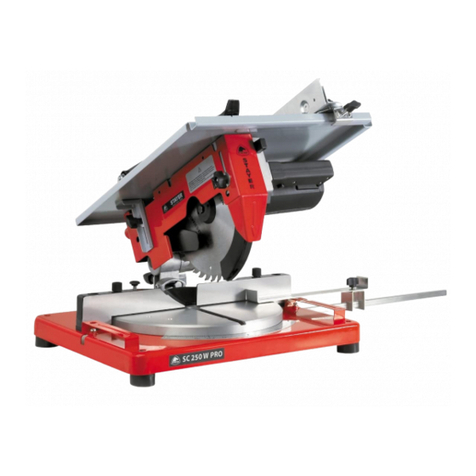
stayer
stayer SC 250W PRO User manual

stayer
stayer SCR315W User manual
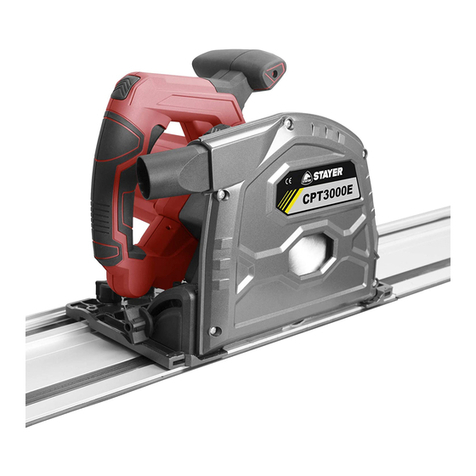
stayer
stayer CPT3000E User manual

stayer
stayer CP190 User manual
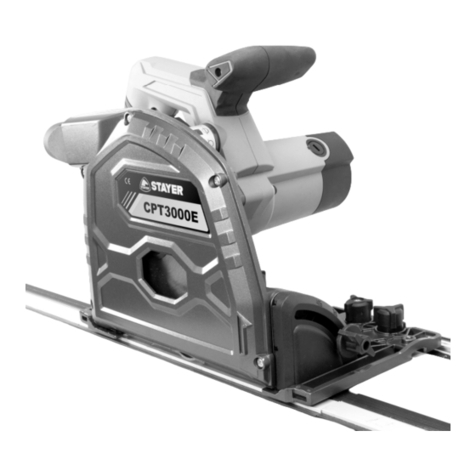
stayer
stayer CPT3000E User manual

stayer
stayer TV509D User manual
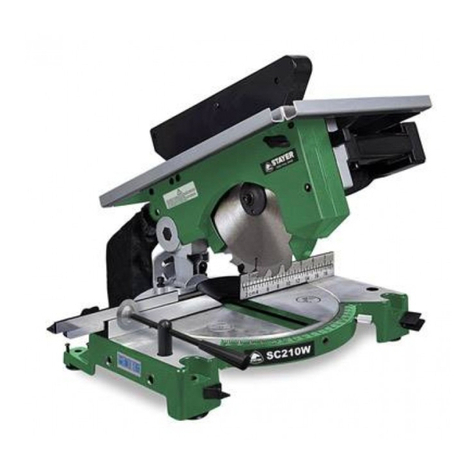
stayer
stayer SC210W User manual

stayer
stayer SC210W User manual
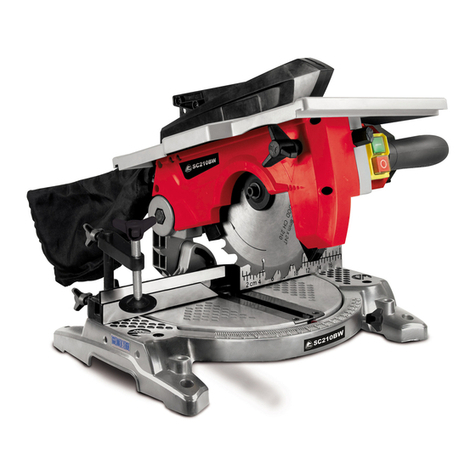
stayer
stayer SC210BW User manual

stayer
stayer CP190 User manual
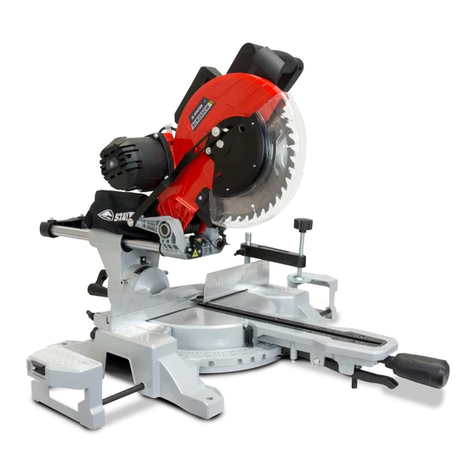
stayer
stayer SCR 255 CW User manual
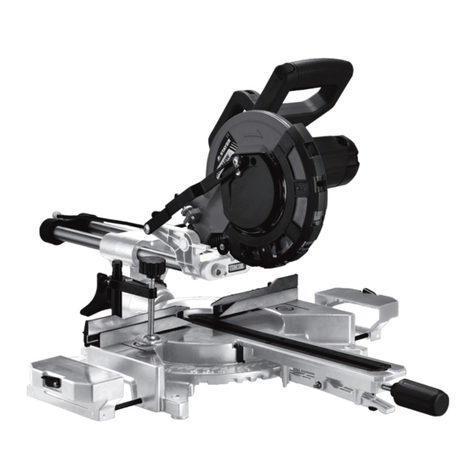
stayer
stayer SCR216W User manual
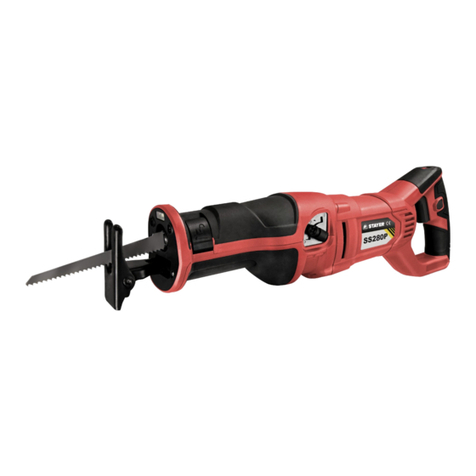
stayer
stayer SS L12 User manual

stayer
stayer SC241W User manual
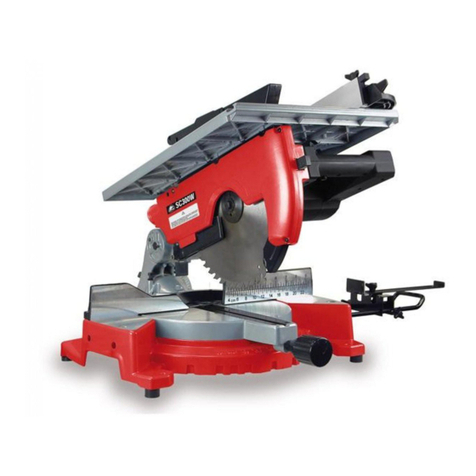
stayer
stayer SC300W User manual
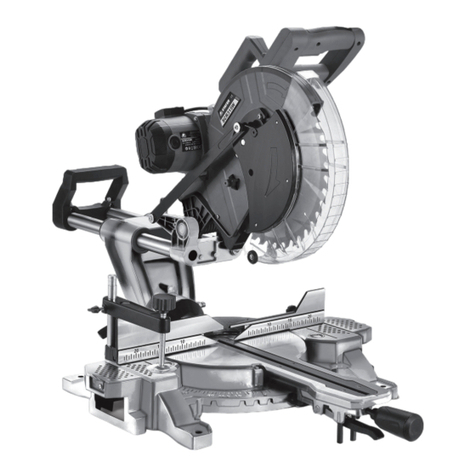
stayer
stayer SCR315W User manual
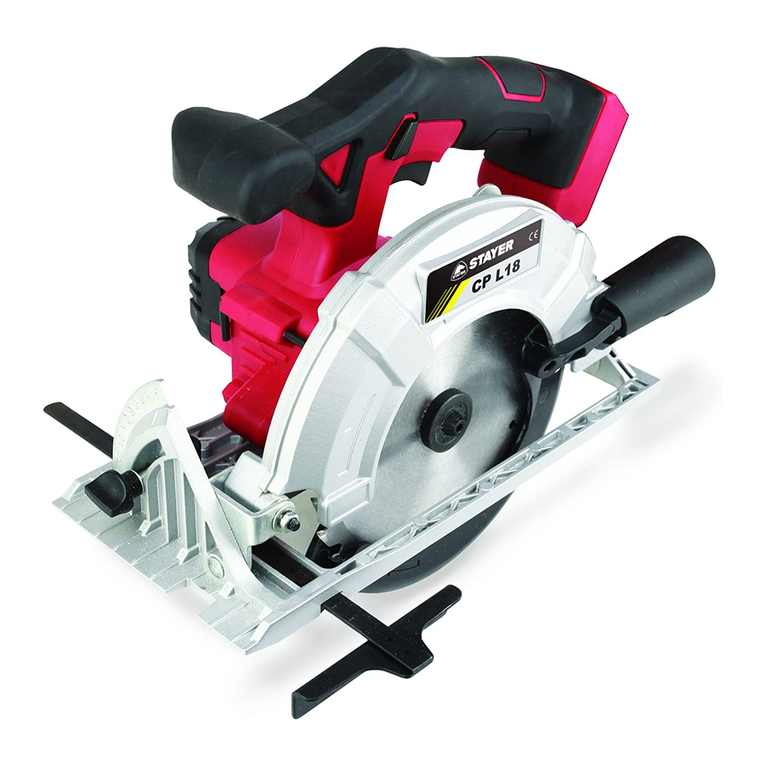
stayer
stayer CP L18 User manual
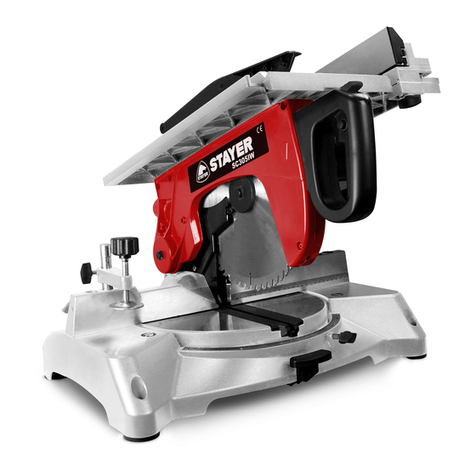
stayer
stayer SC305IW User manual

stayer
stayer CM230K User manual

stayer
stayer TV509 User manual
